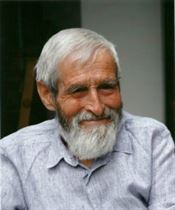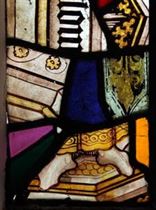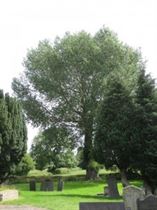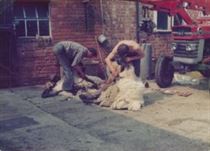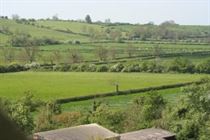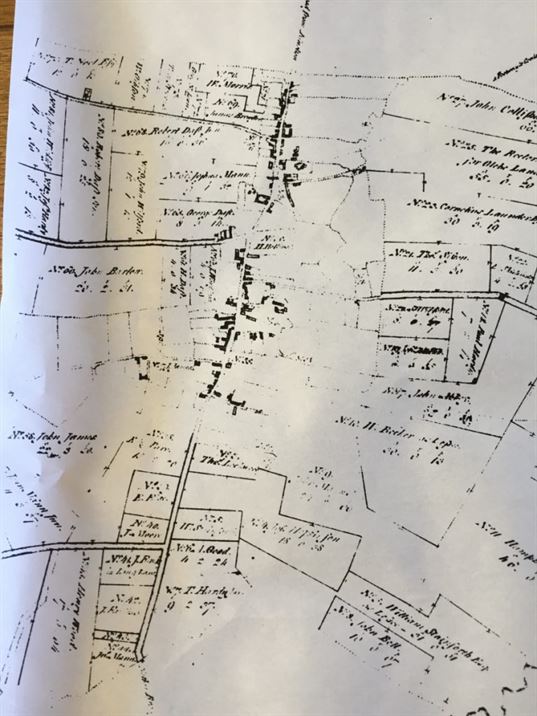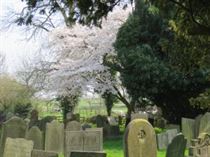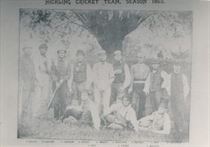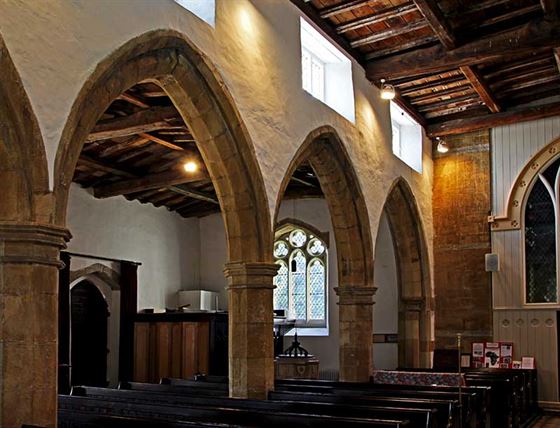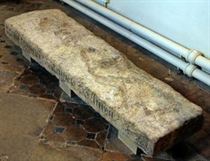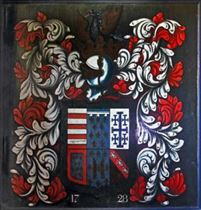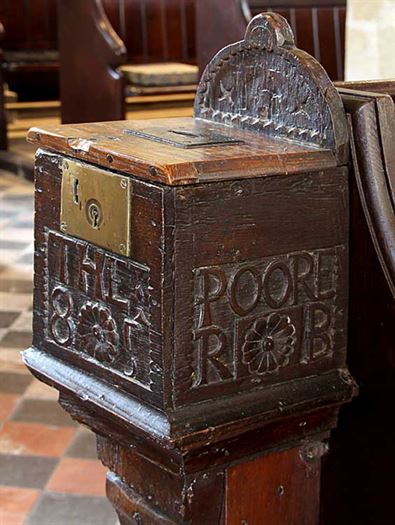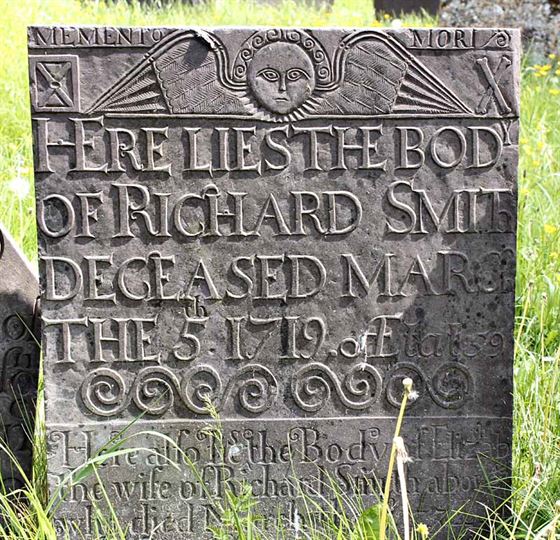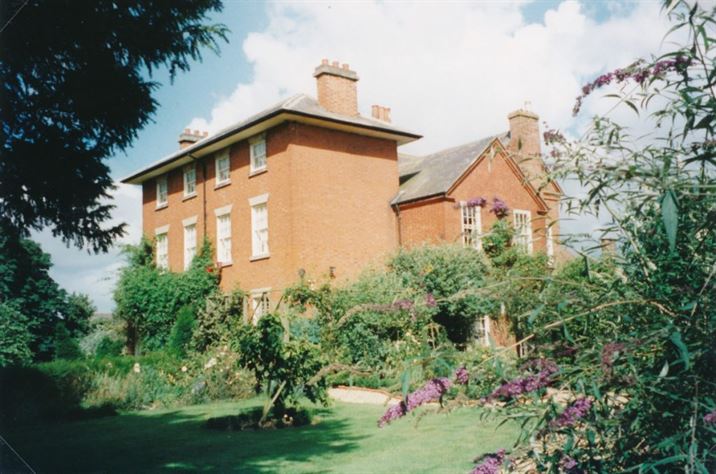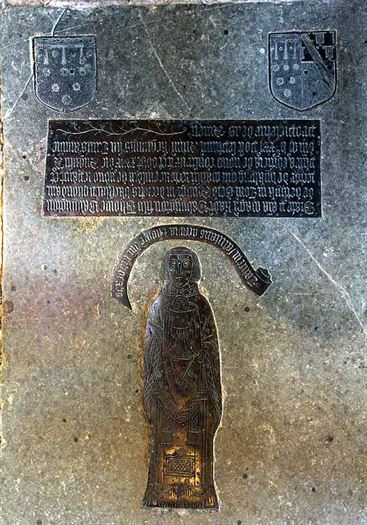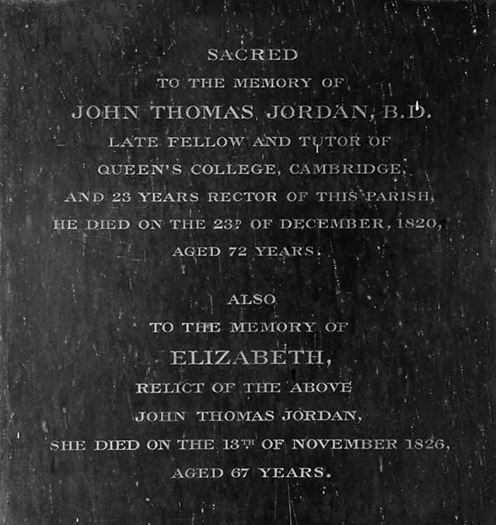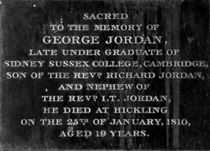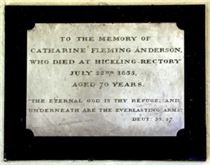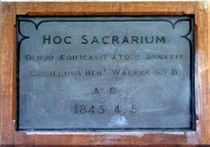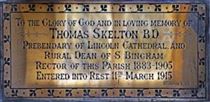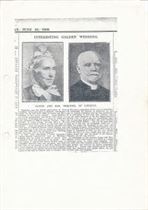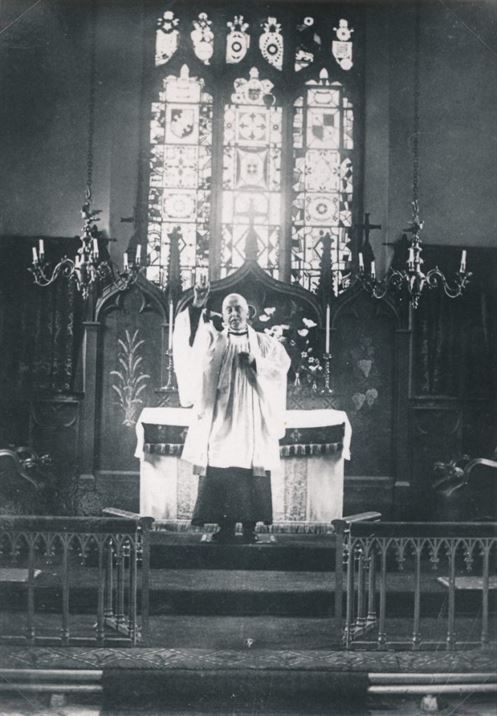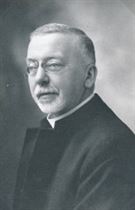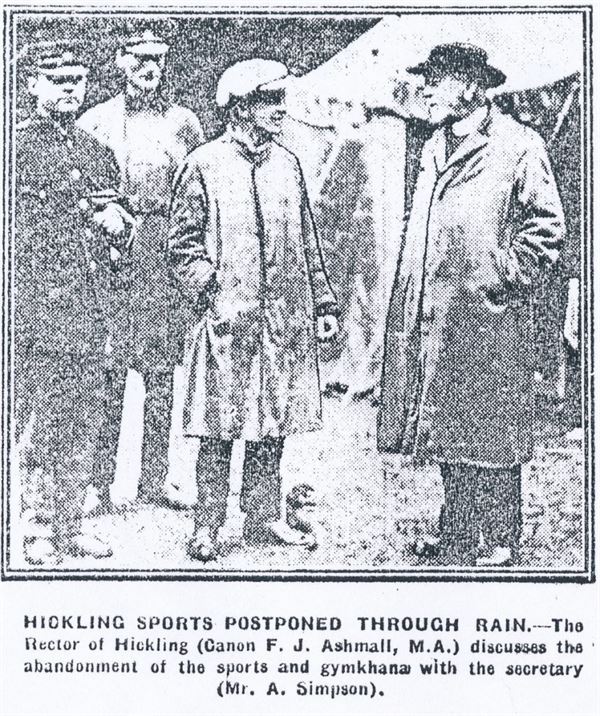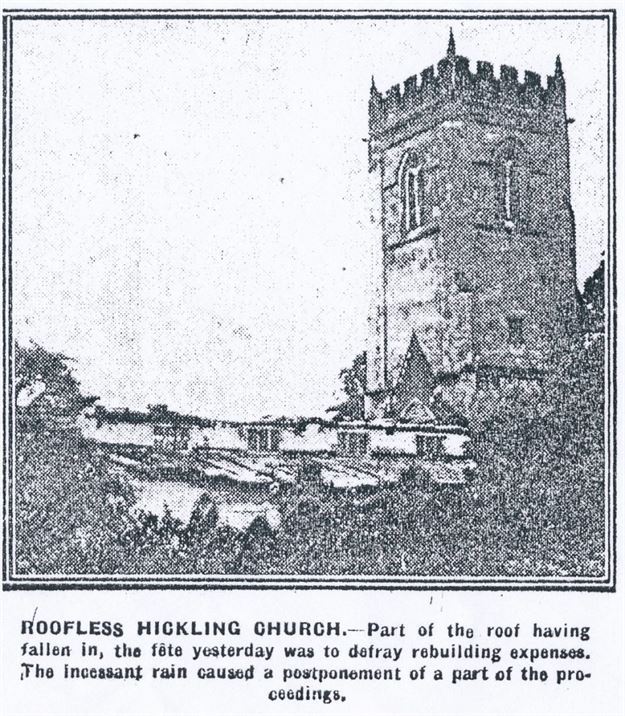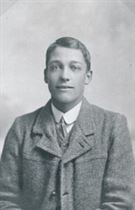A History of Hickling to 1860
and of all its Clergy.
Nemo me impune lacessit
by Christopher Granger
I am writing a history of Hickling from its very beginnings up to 1860 and of all its clergy. I do not intend to cover the remaining period, because Hazel Wadkin’s two books admirably cover the remaining period.
In the 1880s Hickling had a magazine called the Almanac. If anyone has any of them, *I should very much like to see them.
(Chris Granger)
Foreword
Christopher Granger was very much a Nottinghamshire man, his family being Nottingham’s last independent lace manufacturers. He also had close connections to several well-known Nottinghamshire families. On his father’s side, he was a great-grandson of Sir John Turney, leather manufacturer and Lord Mayor of Nottingham, and a great nephew of Professor Frank Granger of Nottingham University. On his mother’s side, he was descended from Richard Warwick, founder of the Warwick and Richardsons Brewery in Newark, and related to the Huskinsons of Langar Hall. Further back he was connected to John Robinson of north Nottinghamshire, pastor to the Pilgrim Fathers on the Mayflower.
Chris was born in Nottingham and spent much of his childhood there. After boarding school at Oundle and National Service in the Royal Artillery, he joined the family firm of accountants. But shortly after qualifying as a chartered accountant in 1961, he had the catastrophic misfortune of an accident in the Noel Street Baths, which left him with a severe spinal cord injury. Only the excellent care he received from Stoke Mandeville Hospital saved his life. It was here that he met his future wife Eileen, whom he married in 1964. Her skill and constant care kept him astonishingly fit both physically and emotionally through the years that followed. The arrival of the two children added an extra and hugely happy dimension to their lives, in turn much increased by the arrival of grandchildren.
Not entirely happy with his job with the national firm of accountants which had taken over the family partnership, Chris boldly set up on his own accountancy practice, and made a considerable success of this. This did not prevent him from pursuing an amazingly wide range of spare-time interests both historical and other. He and Eileen were often to be seen in Nottingham’s “theatreland”, attending plays, concerts and opera. These were complemented by visits to London and elsewhere. Indeed, determined not to be constrained by Chris’s condition, they frequently holidayed abroad. Nor was gardening out of the question. Chris’s great love and knowledge of plants led to creation of a garden with an extraordinary wide range of species. He also had a great love of beautiful books and in all these areas – gardening, books, theatre, opera, music – his enthusiasm was infectious and his knowledge astonishing.
But much of his leisure time (he never fully retired) was spent on his historical research. As a long-standing member of the Thoroton Society, the county historical and archaeological society, he attended many of its functions. He developed a particular interest in seventeenth century tokens, issued as alternative coinage by local businessmen because successive monarchs and governments failed to mint sufficient low value coins for everyday use. This led him to becoming perhaps the foremost expert on the tokens of the East Midlands and the people who produced them. He also explored his family’s history in numerous lines, on his mother’s as well as his father’s side.
But his major project in his later years was on Hickling Church and village, being on the final stages of this at the time of his death. He had been interested in parish churches ever since his time at school in Oundle, where he used to cycle out to visit and inspect the local ones. Even with all his other interests and activities he found time to write the history of Hickling church and its incumbents, on whom he discovered and organised an extraordinary amount of information. It is marvellous that this is now seeing the light of day. He combined this with the job of Church Warden here at Hickling for as many as 27 years.
When one considers the physical problems he faced – the difficulty in actually putting pen to paper, in travelling from place to place, in getting into buildings, just to mention only the most obvious ones – his achievement is astonishing.
Chris’s quiet and gentle manner was unchanged by his accident. A man of great intelligence, he held strong views but did not shout about them or force them on others. A life-long Liberal, he castigated the Conservative treatment of the disabled. In a marvellous example of his determination not to be dominated by his condition, he threw a party to celebrate the 50th anniversary of his accident and the start of his life in a wheelchair. That he survived 53 years after his accident is extraordinary and a tribute to the wonderful care and love he received from his nearest and dearest and the exceptional physique and determination of the man himself. He is sorely missed.
Christopher Francis Kendal Granger 1935-2015.
by John Hamilton
Editor’s Note (July 2020): Sadly, Chris didn’t complete his book and some sections are either incomplete or weren’t fully integrated as he intended – writing this book was a long, long project and there were always new reasons to tinker with it, alter it or to head down new paths. In reality, it may never have been completed but it is certain that Chris enjoyed the writing and the research and the end product may not have been his most important objective! Problems retrieving his research from an aged Mac computer after his death has also added confusion to Chris’s intended wording and, in some cases, we only have fragments. We hope that we have been able to retrieve the majority of his book and that we have been able to retain his voice and the spirit of his writing and research.
We are extremely grateful to his wife, Eileen, and the Granger family for allowing us to include Chris’s work in our Hickling archive.
Contents
* Chris’s manuscript was left unfinished in places and, sadly, it hasn’t always been possible to fill in the gaps as he intended.
** Chapters and sub-headings have been added which weren’t in the original text; this is to enable readers to navigate through the online text more easily.
*** source of images: ‘W’ = Wadkin Archive & ‘CG’ = Chris’s images from the Church History Project.
A History of Hickling.
(see also Appendix 7 for additional notes)
Chapter 1: Early to Sixteenth Century (also including:)
Chapter 2: Seventeenth Century Hickling (also including:)
Chapter 3: Eighteenth Century Hickling
Chapter 4: Nineteenth Century Hickling (also including:)
Chapter 5: War
Chapter 6: The Church and the Churchyard (also including:)
Chapter 7: The Value of the Church and its Living (taxation)
Chapter 8: The Rectory (see also chapter 7).
Chapter 9: Christianity (including:)
Chapter 10: The Clergy (including:)
Some Additional Notes (offered by a friend)
Appendices:
The following appendices represent material that we have recovered from Chris’s research but not incorporated in his main history. They consist of notes and fragments which, we feel, will prove both interesting and useful to his readers. In addition to the material here there are dozens of documents (unhappily mangled by the computer problems) through to the 1970s. Retrieving this research is a large project for another time but we may be able to help if you have a specific query.
Appendix 1: Hickling, A Chronological Table of Events in relation to National and International Events (to 1529).
Appendix 2: Table – Church Officers 1529 to 1977.
Appendix 3: Memoir of 27 Years as a Churchwarden of Hickling.
Appendix 4: Notes Relating to Artefacts and Dates.
Appendix 5: Hickling Property (1856).
Appendix 6: Notes on Field Names, House Names and Road Names.
Appendix 7: Additional Paragraphs from Chris’s Notes (including:)
Appendix 8: Church Officers 1970 – 2013.
Appendix 9: Hickling Trades – seventeenth century.
Appendix 10: Fragment Transcripts of News Articles from the British Library Archives (1580s to 1930s).
Appendix 11: Churchwardens’ Expenses – 1700s.
Appendix 12: Articles of Agreement for the Enclosure Act 1714.
Appendix 13: Extracts from Parish Registers 1622 – 1764.
Appendix 14: Hickling Terrier 1663.
Appendix 15: Hickling Terrier 1687.
Appendix 16: Hickling Windmill (notes).
Appendix 17: Calendar of Patent Rolls 1553 (fragment).
Appendix 18: Hickling Villagers 1400s and 1500s (list).
Appendix 19: St. Luke’s Church, Hickling – Listing Descriptions
A History of Hickling to 1860
and of all its Clergy.
Nemo me impune lacessit
by Christopher Granger
Chapter One: Early to Sixteenth Century Hickling:
The Romans, coming from a civilised society, used coinage to facilitate trade. They brought their own silver denarii and copper aes and soon started minting in several places up and down the country. The Ancient Britons had issued their own small silver coinage. The pieces were very crude and look as though they were designed by cavemen and the images were frequently misplaced on the flan.
After the departure of the Romans, the coinage gradually dropped out of use and a system of barter prevailed.
It is not known whether people continued to live in Hickling from then on but it seems likely. When, later, the Vikings or Saxons came on the scene, they would choose a place where there already was habitation.
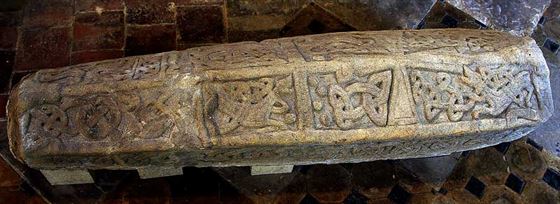
Hickling was settled in Anglo Saxon times by a tribal war lord by the name Heckla and his armed men carrying their axes, spears and swords, followed by their women, children and hangers on. Ing is a Saxon suffix used as a patronymic. This would have been sometime between 700 and 1000 AD. Hordes had been moving across Asia to find greener and safer pastures. These displaced the indigenous peoples who in turn flooded West and over into Europe. Jutes originating in Jutland and Saxons from Eastern Germany found refuge in this country, competing for land with the Vikings and pushing the Picts and Scots further north.
Before they left their erstwhile homes, the Anglo Saxons would have been organized into civilizations, whereas the Vikings were in general mere marauders. They quickly divided the country into kingdoms such as Wessex, Northumbria and Mercia. These kingdoms each had their armies and fought over their territories.
The Anglo Saxons, while controlling the country, suffered continuing harassment and occasional invasion from Danish marauders. In order to placate them, they were forced to pay large amounts of ransom money or Danegeld. They minted large amounts of silver pennies, most of which found their way to Scandinavia. This had to be out of someone’s pocket and the unhappy people chosen were the landowners.
For this knowledge we must be thankful for the early records of landowners in the Domesday book which was a survey of land ownership for taxation purposes. The land was measured in carucates, the equivalent of eight bovates or oxgangs, which were the measure of the amount of land that a man and his ox could plough in one year. Meadows were measured in acres.
The earliest record of the existence of Hickling is in 971AD, when Aernkitel granted some land in Hickling to Ramsey Abbey.
Thomas Thoroton in his History and Antiquities of Nottinghamshire, which was written in the 1770s, wrote that immediately prior to the Norman Conquest, the whole parish consisted of two manors, which belonged to Torchill and Godwin. They were deprived of their lands by William the Conqueror who gave them in the form of two Manors to Ilbert de Lacy, forebear of the Earls of Lincoln, and Walter de Eyncourt, whose grandson, another Walter, restored it to Elias, or Elisius de Fanecourt, who held three parts of the land in Hickling and Kinoulton, of which his father, Gerard de Fanecourt, held of the Earl of Lincoln one Knight’s Fee . The village was then part of the larger parish of Cropwell, which also included Kinoulton and Granby.
Gerald was a great benefactor of Thurgarton Priory and he gave his Manor in Hickling to the Priory.
Ilbert de Lacy leased two parts of the “Town of Hickling” by free farm to Robert de Hareston for nine marks a year. This long lease passed by inheritance successively to the de Grey and Leake families and with it the advowson or patronage of the benefice of Hickling. This can be seen in the section of this book relating to the Clergy. Both the de Harestons and the de Greys took advantage of the advowson by providing a cushy, well paid job for a younger son, who merely had to take the cloth.
The long chain of inheritance was finally broken in 1542, when Francis Leake sold the Manor of Hickling and the advowson to John Constable of Kinoulton for £276
He quickly sold it on to John Ingleby of Ripley in Yorkshire. whose family retained it until in 1604. A later John Ingleby who lived at “Hickling in the Vale” sold the Manor and most of its land and the advowson to William Fairbarne, a resident of the Village whose father, Brian, is described in his will as a yeoman, for £534.
The Inglebys were held in deep respect by some of their tenants. One of them, Rauffe Patchingham, described John Ingleby as “my Worshipfull Mr Inglebye Esq. He possibly felt a little insecure because he had come from Norhamptonshire, where he had two married daughters, and become a tenant farmer in Hickling and had been a church warden in 1553. He would therefore been concerned at his advanced age for his elderly wife and spinster daughters.
William Fairbarne’s son, Gervase, who acquired the remaining land, inherited the Manor from him. From them, according to Thoroton, it passed to the Stapletons. William Stapleton was church warden in 1553. However, I have found no evidence of the presence of Stapletons in Hickling in the 17th century. Gervase himself settled in Barrow upon Soar.
Thoroton then loses track of the ownership of the Manor and lands. In 1585 a James Wilson and a George Warde claimed some land off a John Smith alias Walton and a John Smith who called William Vaux, Lord of Harrowden, as witness. It seems that the Smiths must have prevailed because the Smiths continued to live in Hickling for another one hundred and fifty years. The Smiths’ forebear had been a self made man from Nether Broughton.
In fact by 1629 the freehold of the manor had passed into the hands of Francis Maunsfield of West Leake whose descendents the Mansfields held it for some two hundred years. George Daft, a wealthy yeoman, in his will dated 6 June 1613, left the manor house with all its lands and tenements to his fourth and fifth sons, his four other sons being apparently equally well endowed.
Part of the cause of the confusion is that over the centuries the de Greys and the Leakes gave land to daughters and sold pieces off to outsiders and by the seventeenth century the land in Hickling was divided amongst many freeholders of whom the Stapletons were one. Among the others were Vauxes of Harrowden. The tombstone of William, 3rd Baron Vaux of Harrowden now lies in the chancel of in the church. It was found buried in the churchyard in the 1980s. He was a devout Roman Catholic and refused to attend Church of England services, being on several occasions convicted of recusancy during the reign of Queen Elizabeth I and was committed to the Fleet Prison by the Privy Council for trial and afterwards tried in the Star Chamber on 15 February 1581 together with his brother in law, Sir Thomas Tresham, for harbouring the Jesuit, Edmund Campion and contempt of court. He was gaoled and fined £1,000 (£243,000 in 2013 money).
On the reformation of the monasteries the tithes belonging to Thurgarton Priory were given to Sir Thomas Gresham from whom they passed to Lionel Duckett, sometime Lord Mayor of London, and Edward Whitchurch.
The Leake family continued to hold the advowson, last using it in 1515 to appoint Ralph Babington rector. Babington’s successor, John Bailey, however, was appointed by Sir George Chaworth, who was from an old established Nottinghamshire family. Coincidentally, Sir George’s wife was a Babington. The Ingleby family must have purchased the advowson to go with the manor. They appointed a man from their own back yard, William Atkynson, as rector. They in turn must have sold it to William Fairbarne, a native of the village. His son Gervase in turn must have sold it to Thomas Beane the elder of Aslockton and his second son William. They too sold it quite quickly to Thomas Duckett, son of Sir Lionel or perhaps one of his grandsons. In the early 1600s Edmund Bardsey, rector of Hickling purchased the advowson and this is recorded in his will as being from Master John Duckett. He in due course used it to appoint first his son James and then his nephew George Fisher, who served as rector for 63 years. In1667 Edmund’s widow bequeathed the advowson to Queens’ College Cambridge, the present patrons.
Magna Carta 1215
Years of misrule by King John led to open revolt by his barons and he was forced to sit down at Runneymede and grant them a code of rights. Whilst the barons’ chief concerns were their own rights and freedoms, much of it was of benefit to the common man. Such vital rights as habeas corpus and jury trial were granted, and these have been sacrosanct ever since. Sadly, our present Tory LibDem Government, as did its New Labour predecessor, would like to take these rights away from us in order to reduce costs and to protect us from terrorists.
One area, which Magna Carta, did not cover was the right to gather firewood from the Royal Forests, but this was rectified by the Forest Charter in 1217. This allowed anyone other than a merchant to take firewood either for his own use, or to sell so much as he could carry. A freeman could also gather nuts and fruits of the forest for his own use or drive his swine through the forest.
Taxes
In 1227 the Prior of Thurgarton did not claim his right of Assize of Bread, Gallows or Tumbrell against the wishes of the Crown but the Court found in the King’s favour in 1327 and a rent of eight pounds per annum was granted to the King for the Assize of Ale. At that time the value of the Manor of Hickling to Thurgarton Priory was £24.5s.2d per annum, coming from four carucates of land at forty shillings apiece, two dovecots at twenty four shillings each, a windmill at twenty shillings with the rest coming from numerous freeholders, bondmen and cottagers.
The dovecots were a symbol of prestige and, in the days of the Plantagenets, only noblemen were allowed to own them.
The Assize of Bread and Ale was introduced in the thirteenth century in order to set standards of quality, measurement and pricing for bakers and brewers. For bread the standard measure was for a farthing loaf, which had to weigh 6lb 6 oz. It presented an established scale of ancient standing of pricing between the wheat and the bread. The assize continued in being until comparatively recent times.
In a similar way the assize regulated the price of a gallon of ale by the price of wheat, barley and oats. By the sixteenth century this uniform scale of price had become extremely unpopular and in 1531 the law was changed to allow the ale to be sold at whatever price the local magistrates should think appropriate. From ancient times the quality of the ale was assessed by officers, known as gustatores or as ale conners, who were chosen annually, by the Court Leet of each Manor. The magistrates were very strict with the brewers whom they brought before the courts regularly.
Beer or ale was both an important food source and something safe to drink. The average man would drink some five pints a day. All households needed it and only the very meanest dwellings did not have the facilities for brewing.
The brewing was done mostly by the women of the household and they did it in addition to their other household chores. It was a very slow process. First the barley had to be soaked in water for several days and then drained off and allowed to germinate. This was a tricky business. The germinated barley was then dried out with heat and ground into grist. Hot water was then added and soaked up the goodness and flavour of the mixture to create the wort, which was then drained off and herbs and yeast were added to it. When this had fermented it had become ale, which only had a useful life of a few days. At first, only the larger households would have had the facilities and the equipment for brewing. This would consist of a lead or a copper vessel and several tubs and pots. Over the centuries more and more households took up brewing. Any surplus ale was offered for sale either in the house or to callers. In years of famine the barley was needed for food and fodder and some local authorities imposed fines on people brewing their own beer.
The life of an ale wife in a town is described somewhat colourfully in the poem, The Tunninge of Elenor Brunning by John Skelton in the late fifteenth century, from which the following extracts are taken:
“And this comely dame,
I understande, her name
Is Elenor Brunninge
At home in her wonnynge;
And as men say
She dwell in Sothnay,
In a certayne stede
Besyde Lederhede.
She is a tonnishe gyb
The devil and she be syb.
But to make up my tale,
She breweth nappy ale.
And maketh thereof port sale
To travellers, to tinkers,
To sweters, to drinkers,
And of good ale drinkers,
That wyll nothynge spare,
But drynke tyll they stare
And brynge themselle bare,
With, “Now sway the mare,
And let us slay care
As wyse as an hare”.
“Good fellowship: one man drinks to keep another company.
A second end of drinking is said to be the maintenance of friendship and kindness among men.
A third end of drinking is said to be cheering their spirits, making them merry and jolly.
A fourth cause of drinking is said to be to be the putting away of cares.
A fifth end is the passing away of time
A sixth end is said to be the preventing them of that reproach which is cast on those that will in this be stricter than their neighbours”
(I am indebted to Kate Loveman of Leicester on the letters page of the Guardian for this quotation.)
Sports And Pastimes
In the reign of Edward I a law was passed banning men below the ranks of the nobility and squirearchy from taking part in any other sports than archery. This was to ensure that Edward’s bowmen honed their archery skills. It is likely that such sports as running races would have been looked at with a blind eye. In Norman days and after, handball was played using a blown pig’s up bladder but with the hand towards one’s opponents rather as in tennis today with the object of preventing them from returning it.
Stool ball was also played with the players throwing the ball at a stool with the object of hitting it. Also, there was a primitive form of bowls but at one time this was banned for the peasantry.
Indoor pastimes were essential for the long, dark evenings would include dice and singing and rustic dancing.
The Black Death
In 1346 the rat borne Black Death swept relentlessly throughout the Western world, bringing with it death, suffering and tragedy. It arrived in England borne by rats. Grandparents weeping at the sight of their dying progeny and widows and sweethearts grieving for their loved ones. Only eye witnesses can testify to the suffering and recommended reading; if you want to find out more, it can be found in the writings of Thucydides, Agliona, Boccaccio, Pepys and Albert Camus. Furthermore, it returned at regular intervals over the next two or three centuries.
Records do not exist as to how it affected the people of Hickling but undoubtedly it would have caused many deaths and blinded others. It hit Nottingham in 1349 and it is believed that some half of its population died. The initial outbreak and its successors so depleted the population that some villages were abandoned.
Eighty three lives were lost in Colston Bassett in 1603 and Nottingham was afflicted by it in 1609. Hickling’s parish registers from before 1621 have been lost but evidence from wills and the existing parish registers suggest that some families were reduced in numbers in that period. Five members of the Noble family were church wardens or swornmen between 1601 and 1607 but the last entry for that family in the parish registers was the death of John Noble in 1635. The Hopkinson family also appears to have suffered several losses.
Suggestions that the plague returned to the village in the 1660s do not appear to be supported by hearth tax returns, parish registers or wills.
Small pox and other diseases were a constant threat. Small pox could leave you disfigured or blind and measles could leave you deaf or blind and as late as the 1920s some thirty percent of its victims died. Medical assistance was in short supply. People knew to boil their water before drinking and beer was part of the staple diet. Cholera was rife. There would have been no more than one or two Doctors of Physic in Nottingham. Apothecaries would have, to a large extent, filled the gap. They would have had a wide variety of medicines, spices and poisons to kill you or cure you but in either case their remedies might do more harm than good. Letting of blood did not usually help. Extracting teeth without an anaesthetic was very painful as was any form of surgery. Barber surgeons were tradesmen not professionals.
Early in seventeenth century Hickling, those who survived to adulthood often died in their thirties or forties, many women through sheer exhaustion from the number of their pregnancies. Death in childbirth was common even up to the twentieth century. As nowadays, some couples were unable to have children and others found that their babies were weakly and few, if any of them, grew up to adulthood. With the best will in the world the doctors, whom only the rich could afford, were unable to provide much useful help. Contraception was not available and few practiced any form of restraint to the sexual urges. It is sometimes said that infant mortality was so common that people hardened their hearts towards it but my great grandmother Emily Sarah Branston, on the death aged five of her third child was so upset that she immediately abandoned her beloved family scrapbook. By contrast, of those who survived childhood, many would live to a ripe old age.
Establishment of a New Pattern Of Life After The Black Death
In Norman and Plantagenet times the monarchy, nobility and landed gentry owned most of the land and the feudal system. William the Conqueror had to quash several rebellions by the Anglo Saxon nobility after seizing power at the Battle of Hastings and punished them by confiscating their land and property redistributing among his own relations, nobles, and other supporters. These lands were held in a fief whereby the overlord granted heritable property to a vassal in return for certain obligations such as military service, the provision of fighting men and the provision of produce from the land. The lord of the manor lived in the manor house. The other inhabitants of a village were the serfs or villeins who lived in mud brick cottages, which consisted usually of one room only which was heated by a fire. The serf would also farm a strip or strips of land in his own right, the amount of land being decided by the lord of the manor. He would also be required to work on the landlord’s land or work for him in some trade such as a baker, cook or blacksmith.
Chapter Two: Seventeenth Century Hickling
By 1600 Hickling was a large village, having by the middle of the 17th century some 350 inhabitants. Of necessity it was in most ways self-sufficient. Transport and communications were slow. The wealthier members of society would have had horses or even carriages but highwaymen might rob even the most canny traveller. The roadside gallows with corpses hanging upon them were no deterrent to the serious highwayman or his fellow criminals.
When illness or misfortune struck, people may have put the blame on something which they or their communities had done but, if tragedies occurred, more than once, they would turn to their superstitions and in extreme circumstances even blame witchcraft. Two young women and their cat were hanged in Lincoln gaol for causing the deaths by their spells of two young heirs of the Earl of Rutland. Recent research has shown that the real cause was epilepsy.
Hickling’s inhabitants were self-sufficient in most things. Food was supplied by the many farmers and there would have been bread, meat and vegetables, as well as clothing and other sorts of the things needed to live a simple life. The farmers had all the help they needed to till the fields and to do any menial jobs. Imported goods were readily available in the towns. Market towns uses to have fairs where less commonly available wares could be obtained and provided sometimes all sorts of fun. The women would have had delicious recipes to make the limited variety of food more appetising and all manner of fire irons and utensils to ease the cooking. Water would have been drawn from local wells and washing done in the rivers and streams. All the larger houses had brewing facilities and there was a plenteous supply of beer. Women had control of this function and would ferment the malted barley and brew the beer which they would take out to their husbands in the fields.
People had to while away the long dark hours of winter and they congregated in the local pubs or larger houses where they sold their surplus ale. Games of dice and cards were played with more physical games being saved for the lighter evenings. Women could spin and make clothes while minding their children. Unless they were either unmarried or spinsters, women could not hold property in their own right. Tobacco had spread like wildfire since its introduction by Sir Walter Raleigh, and by the middle of the seventeenth century most men smoked. Grocers, merchants and apothecaries as well as many other shopkeepers, regardless of their usual wares, catered for their addiction.
Sports And Pastimes
When not at work, there were various forms of entertainment. The more energetic could play a rudimentary form of football with a blown up pig’s bladder, some variety of wrestling or a tug of war. Cock fighting was also popular. An Act of 1541 forbade the playing of bowls by artisans, labourers and servants on any day other Christmas day outside their gardens or orchards. Playing elsewhere would make one liable to a penalty of 6s. 8d. This law was not repealed until 1841.
The old strictures on sports were, probably, hardly thought of in a village like Hickling which had no squire.
All forms of gambling, card games such as […] and cribbage. Blind man’s buff was played by both children and adults. Children would have hide and seek, tag and many other games. Mainly because of lack of reading skills but also because of the small number of books, reading had not caught on but there would have been plenty of opportunities for singing. Festivals and feast days were celebrated enthusiastically. Fairs in local market towns provided other exciting attractions. Occasionally, strolling players would visit
Skittles was popular in the pubs around Leicester but it was played on a hooded table and was known as “Hooded Skittles” The table was leather bound with leather padded walls to the sides and back. The hood was curved like a pram and made of leather or netting. The table was about three feet high and three feet long.
The Weather
As is well documented. the winters were very cold and snow covered the soil for months at a time. Paintings of skating on the Thames and Breughel’s rustic scenes are evidence of the harshness of the winters. In Selston’s parish register “the great snow” is noted on 30 November 1658.
Lighting
Light in the dark evenings and nights would have come from candles, braziers and the flickering flames of the hearth which will have been diligently nurtured during the day. The only tallow chandler who operated in Hickling whose name has come down to us was Robert Collishaw who died in the early eighteenth century. It is not clear from his inventory whether he actually made the candles himself but it is probable that he did and in all likelihood he did. The explanation seems to be that he had retired and his son had succeeded to the business and already owned the candle house. Even so candles were available at most grocers, merchants, ironmongers and tobacconists, as well as in most villages.
At the time, John Markham of Bingham, who had substantial facilities for making candles, probably catered for most of the villages in the area. However, John Brown and Arthur Cloudsley in Melton were alternative suppliers. The candles for the altar at the church were made of wax and would have come from some distance away.
Inheritance
It is difficult to know what trades individuals carried on, as the only sources are marriage licenses, probate documents and to a lesser extent parish registers. In many cases generations of a particular family worked in the same trade. Examples of occupations found in seventeenth and early eighteenth century Hickling follow.
Yeomen and tenant farmers and labourers were too numerous to mention.
The younger sons would either be put out to apprentice to some trade or seek tenancies either within or outside the parish. The lucky ones would marry their master’s daughter when he had no sons or the daughter of a local farmer in similar circumstances. The daughters would either marry or go into service but occasionally they were apprenticed to a trade. Many younger sons and daughters never married. Even in those days some testators divided their estates more equally but this dissipated the family wealth.
Trades And Businesses
The following examples have been found up to 1740:
The word ‘taylor’ was used in its legal meaning in the documents from which this list is drawn but could refer to the maker of clothes in those days.
I have been unable to find any indication of a public house or inn in seventeenth century Hickling but most of the larger houses had copious supplies of beer and some would open their houses to all and sundry. The owners of those houses would have needed a license and in times of famine, the authorities clamped down on such drinking and brought anyone caught opening their doors without a license would quickly be brought to the beak and suitably punished. This would consist of banning them from entering a drinking house [… or habitual drunkenness]. Those […] would face the threat of distraint.
A man would want his pint after a hard day of ploughing or harrowing. A woman, likewise, coming from her domestic drudgery. As today, people sought comfort in the warmth and camaraderie of the local. Your choice of tipple was very limited. At the most important inn in a town, you could have had brandy, sack, Rhenish or the tavern’s own brew.
In 1659 Richard Allestree in “The Whole Duty of Man” identified the motives of the, “… multitude of drunkards in the world […] since an alehouse is often the room in a neighbour’s house”:
“Good fellowship: one man drinks to keep another company.
A second end of drinking is said to be the maintenance of friendship and kindness among men.
A third end of drinking is said to be cheering their spirits, making them merry and jolly.
A fourth cause of drinking is said to be to be the putting away of cares.
A fifth end is the passing away of time
A sixth end is said to be the preventing of that reproach which is cast on those that will in this be stricter than their neighbours”
(I am indebted to Kate Loveman of Leicester for this quotation.)
Most of the artisans would have traded independently but a few of the more enterprising folk would have employed specialist tradesmen. At the end of the seventeenth century John Daft at the Hall, a wealthy yeoman, was employing weavers such as Charles Wollerton to turn the yarn which his womenfolk had spun into cloth, though their relationship may have been more one of subcontractor than employee.
Sheep provided wool and flax the linen which the women toiled away at spinning. Robert Collishaw’s wife had twenty yards of linen cloth and a large amount of weaving wool when he died in 1722 and three shepherds left wills. Keeping it in the family, Edward who died in 1737 was a “stockener”. The women in John Daft’s household ran a spinning business. There were tailors for both sexes. Daniel Daft was one in 1687.
As well as spinning and weaving, the women busied themselves with cooking, brewing, dressmaking, washing and bringing up children, found time to gossip and do a little lace making on the side.
From the end of the seventeenth century and much of the following one, inventories indicate that some Hickling farmers were breeding horses but for what use whether hunting or general use is not clear.
The stocking frame was invented by William Lee of Calverton (Notts). The machine imitated the movements of hand knitters and he demonstrated the operation to Queen Elizabeth in the hope of being granted a patent but she refused on grounds of concern for the livelihoods of the knitters and the widespread unemployment that might ensue. On refusal also by James I, he transferred his operations to France in the hope of greater success but died in 1614 without being adequately rewarded for his ingenuity. The frame which he invented had eight needles but with Lee’s commercial failure his assistants drifted back from France. One, John Ashton, added a “divider” to the workings which was a major improvement.
By the end of the seventeenth century the Huguenot silk spinners had fled France, scared for fear of their lives after the St Bartholomew’s day massacre and took the industry up in a big way. They settled in the then village of Spittalfields and in 1663 The London Company of Frame Work Knitters was founded.
To start with the frame could only produce course fabric. By 1598 the machine had 20 needles and silk could now be knitted as well as wool.
Because Hickling was in a bit of a backwater the stocking frame did not reach Hickling until the 1670s when Stephen Pickard of Lambley married a widow from the village. In the few short years left to him, he fathered several children and acted as overseer of the poor.
Local Government
Village affairs were effectively run by a group known as the neighbours who appointed from among themselves, annually, an overseer of the poor and a constable. In some parishes the duties rotated among the families. Tindall of Upton’s report on the bailiff’’s attempts in 1646 to distrain one of his parishioner’s horses could have been made by the constable in “Much Ado about Nothing”.
“When Randle Leaver’s son came through the towne to warne he spent six pence on the first occasion and two shillings on the second and in connection with that and providing the neighbours with sustenance when he consulted with them.”
A few days afterwards, Tindall paid the duties which had been levied over to William Leavers for Robert Sylvester, the chief constable of Thurgarton hundred. This set Upton back a further five shillings in his expenses.
The church wardens came from the same source, (duties included) to arrange the lodging of passing travellers and to ensure that travelling paupers or vagrants and particularly poor pregnant women were rushed out of the parish by nightfall in order to make sure that they and particularly their progeny did not become a charge on the parish resources. Poverty was a major problem. In 1674 twenty of the ninety households in the village were discharged by certificate from paying hearth tax. On 17 January 1618 the church wardens and overseers of the poor were ordered by the Ecclesiastical Court to provide accommodation for a man and his wife and family who had been evicted from his house and had been forced to live in a beast house in the fields.
Between 1620 and 1640 Hickling’s neighbours came from the following families:
Of these the Gunthorpes, Smiths and Waies were variously described as gentlemen or yeomen. The Gunthorpes provided two generations of Chief Constable of South Bingham hundred. The Parlebys were bakers. a very important trade in those days and highly respected. The others were yeomen or tenant farmers. The Gills moved over from Old Dalby or Dalby on the Wolds as it was then known. Edward Collishaw came to Hickling in the first twenty years of the seventeenth century. He may have married an heiress inherited it or, less likely, bought his land in Hickling. He may have been born in Plumtree.
It is unfortunate that the names of very few of the constables and overseers have come down to us. The parish registers and bishops’ transcripts preserve the names of the church wardens for much of the seventeenth and eighteenth centuries.
People used to refer to their village as the town.
Hickling was not on a thoroughfare and would not have been troubled with all that many travellers but, if any came, some householder would have had to give up or more probably share his or her bed.
Throughout the seventeenth century the Church, which was very powerful in those days, kept a strict attitude to immoral behaviour. The Vicar of Mansfield and his strong minded church was not tolerated either. William Robinson of Retford was fined six pence for attending a sermon by his brother, John, who was pastor to the Pilgrim Fathers. They were so severely oppressed that they fled first to the Netherlands and then to America. Richard Southworth, a yeoman from Retford, moved with his young family to Mansfield to set up afresh and later became church warden there. Some were even indicted for repairing the churchyard on the Sabbath day. Later in the century these pressures eased, though Quakers continued to be persecuted and lists of non-attenders at church survive.
Being in a backwater, Hickling would not have been greatly exposed to the Civil War, though legend has it that there was a battle on the Standard. The parish would, however, have been required to provide a few soldiers to assist the Republican cause in Nottingham and external food supplies may have been [scarce]. Particularly in the earlier part of the seventeenth century and before that, the church exercised strict controls on the morality of its flock. Apart from such matters as drunkenness and sexual immorality, it strongly disapproved of failure to observe the sabbath day and marrying at the wrong church.
Village Childhood
The lack of knowledge of, or interest in, contraception, high infant mortality and the desire to have successors to take over the family business and to look after them if they grew old or feeble, and some people did have long lives, made them have many children. Wives produced children year in year out until they died or were rescued by the menopause. They had to harden their hearts to the frequent deaths of their beloved offspring, though this did not mean that they suffered any less than we do when tragedy struck. This is poignantly expressed in a stained glass window of Bunny church.
My great grandmother, Emily Branston, when her son, Godfrey, died aged five, stopped keeping her scrapbook of newspaper cuttings which described all the lavish civic banquets and society weddings which she attended. Those who were not blessed with children would have been as jealous as some of us today but they had to harden their hearts and enjoy their numerous nephews and nieces. The grandparents would be in charge during the day and from a fairly young age the children would be encouraged to help in the home or at the farm or the father’s place of business. Boys were forever boys and girls were forever girls and they would play, girls with their rag dolls and boys with their toy swords and toy guns. and sometimes get up to mischief. Then they would have smarted with the sensation caused by the meeting of Granny’s swarthy hand or Granddad’s knobbly walking stick.
From the day that they were born babies were heavily swaddled and either lying in their cradles when their more earthly needs were not being attended to while rattling their rattle or string of beads. Mummy or Granny, or was she Nanna? would sing lullabies or gently rock them. As soon as they could crawl, they were dressed, still warmly, in smocks whichever gender they were and girls wore bonnets. They wore no nappies and would simply be followed around with a mop and a scoop, for there were no carpets in their houses. Doting Grandmas and Grandpas would endlessly recite Nursery Rhymes such as “Humpty Dumpty”. “Humpty Dumpty” was a drink made of brandy boiled in ale and satirical cartoonists like George Cruikshank used him for poking fun at their victims. “Hey diddle diddle the cat and the fiddle” was another favourite but they may have said “Hey, nonny nonny no” as in Shakespearian days. To suit the palate “Pease Pudding hot pease pudding cold ” and “Christmas is coming, the geese are getting fat” would have been popular.
The Ecclesiastical Court and its Treatment of Ordinary People
Instances of court appearances of local people follow.
1587: William Atkinson, parson, Thomas Noble and William Howitt, church wardens and John Warde, curate, came before the court by Thomas Jesson and Ralph Pecke who were perhaps constable and overseer.
“We present Mr Fearbarne for that he did not receive the Communion this last Easter for that he and the parson were not friends
The lead of our church is something in decay but we appointed a workman to mend ye same.
Our parishioners did ring corfew upon Alseynte evening but who they were we do not perfectly knowe”
(ringing the bells on All Saints Eve (Halloween) was considered pagan)
12 December 1601. Edward Bloode and Jane Randall of Hickling were accused of marrying at the wrong time. Edward admitted that he was married on 1 December by Mr Warde, the Curate of Hickling, and that there were present one Stephenson, Robert Dafte, George Dafte, Thomas Musson, Thomas Harris and Thomas Dafte. He was automatically excommunicated and afterwards absolved and dismissed.
3 February 1613 Richard Waies and John Musson, the then church wardens were charged that “theie suffer the churche porche to be unrepaired and the seates are not decentlie kepte”.
29 October 1613. The case of Alice Stubbin alias Rustat v William Stubinge was heard. Alice was claiming non payment of a legacy. Each side was represented by an advocate, Mr Gymley for the plaintiff and Mr Brandreth for the defence.
The case was adjourned until the following Thursday and the defendant was warned to attend and produce the inventory of Henry Stubbinge. William Stubbinge failed to attend on 11 and 26 November but appeared on 10 December but without the inventory and contested the allegation.
On 10 February the judge summed up. The plaintiff had asked for an adjournment until a fortnight the following Saturday to prove her case. Claim his expenses.
On 25 June 1614 William Walker of Upper Broughton was charged with
“usinge himselfe disorderlie in the chuche porche and church yarde by givinge threateninge and revilinge speach to William Shawe uppon the Sabbath daye”
In 1619 Helen Burton of Mansfield was charged with sorcery. She could not be met with but was cited as “vile et media” and excommunicated.
On 12 January 1618 the church wardens and overseer of the poor of Hickling were ordered to provide for a poor man and his wife and children who had been turned out of his house and had since lived in a beast house.
On 15 January 1621 Agnes Dickenson of Owthorpe was presented for usury and “that she taketh about tenne pounds in the Hundred” Elizabeth Peller was charged with a similar crime.
On 2 June 1621 John Gervis of Upper Broughton was charged with swearing in the chancel of the church there. He admitted the offence and did use some “unfitte speeches”. He was ordered to do penance.
23 March 1623 Francis Daft appeared for his father, Thomas, a Hickling yeoman, and paid into the court two pence due to the parish clerk for half a year’s tithes on one part of a dwelling house in which he maintained.
On 7 November 1623 Thomas Litster, Margery Frauncis and William Hewkesley of Upper Broughton were charged with “going to the boys at Wisall”
George Daft’s (died c 1613) third son, Thomas, was clearly an argumentative type and George’s will provides that “if the said Thomas my sonne shall or could ere hereafter kikke moleste or sue any of his brothers or sisters for or concerning my houses or lands by this my last will and testament unto them or any one of them given or bequeathed, then this present guift or disposing of the said messuage, dwellinge house, close oxgange of land meddowes and pastures and other the guift before mentioned unto the said Thomas Dafte shall forthwith cease and become void”. While this warning in his father’s will appears to have worked, his combative nature was still in evidence in 1624 when the then church wardens with the blessing of the rector, Dr Edmund Bardsey, took him before the Archdeaconry court as follows: “Thomas Dafte the elder, one of the churchwardens of Hickling, was lately presented by them for divers defaults and misdemeanours committed within the township and church of Hickling, before ‘your worship’; they have not yet had sufficient reformation worthy of his offence; therefore, with the voice and consent of Mr Doctor Bardsey (parson of Hickling) they humbly pray that the said Thomas Dafte the elder, who was presented for his perverse dealings and his railing and slanderous speeches and for his reviling, scornful and reproachful wordes with the church, and for other misdemeanours, may have his submission or penance enjoined on him without delay, to be done within the said church of Hickling, seeing that he has not cleared himself”.
12 June 1624. William Musson, John Peele, Robert Jesson and Elizabeth the daughter of John Browne were taken to court for not coming to church at the appointment of the minister to be catechised. They were dismissed with a warning.
8 June 1669. Samuel Atkins was charged with teaching schools without a licence but he had already gone away to another part of the country
17 May 1670. Robert Smith of Hickling and Elizabeth, his wife, charged with having had a clandestine marriage. They admitted that they had been married without banns or a licence at Stonesby where Elizabeth then resided.
22 November 1670. John Caunt of Hickling and Dorothy his wife admitted at the Court that they had been married at Hose on 26 December last without a licence or banns.
Amazingly the Church of England has hardly relaxed its rules as to when it would marry you ever since. It is only from today, 1 October 2008, that it will allow you to marry in any church of any parish where one of the couple has lived for six months or even their parents or grandparents have lived. If not, you have to go through the hassle of obtaining a licence.
Chapter Three: Eighteenth Century Hickling
Thoroton, writing in the 1770s, noted that the Lordship of Hickling contained upwards of 2,000 acres which were owned by a Mr Londel and others which were enclosed about fifteen years ago. He also said that Hickling lies in ‘a very miry pat of the county’ and consists of about 70 dwellings.
In 1707 the villagers of Hickling were ordered to assist those of Colston Bassett in scouring the River Smite but refused to do so. They were taken to court over this but won their case.
In many ways life would have become easier in the eighteenth century. Religious dissenters were tolerated. There were no civil wars. The Plague ceased to be such a threat. Infant mortality dropped and large numbers of children survived to adulthood. While this would have saved families much distress, the explosion of the population created an excess of labour and there were not enough jobs around. This meant that wages would have been low. Several lads migrated to the towns where they could obtain work or exploit their trades but living conditions were more cramped and for the less well off the slums were a living hell apart from the strong neighbourship bonds. Cleverer boys could prosper. Richard Smith became an attorney and Stephen Daft a tanner.
The Enclosures Acts gave rise to our familiar hedges and ditches. They came about because of pressure from farmers who believed that, if all their land were in one area instead of the strip system, they could farm more efficiently. They came to Hickling in 1776. Hedges were planted and ditches dug extensively to delineate boundaries. For a short time this brought employment for the labourers. Later in the century the Industrial Revolution provided poorly paid employment in abundance and poverty, while remaining a severe problem for them, migrated from the villages to the towns. Tuberculosis became endemic in the slum dwellings of the workforce in the towns and diseases such as smallpox, typhoid, scarlet fever, diphtheria, measles and mumps.
Hickling remained almost fully involved in agriculture and self-sufficient in all the central trades. Unsurpisingly, framework knitting provided profitable employment for many local people, both male and female. It being a major industry in the area. Frames were purchased and hired out by the better off people to some of their neighbours and were regarded as a sound investment. Elizabeth Daft, an elderly spinster, left two frames in her 1798 will and mentioned Ann March, Jack Moulds and Ann Morris or Hickling and Ann Barnett of Long Clawson as knitters.
More and more people turned to the frames for their bread and butter. The only names to come down to us from the first half of the eighteenth century are Edward Collishaw and a relative of his who had moved to Nottingham and Paul Shipman.
While the industry had spread massively throughout the Midlands, little had happened to improve the mechanisms of the frame until 1758 when Jebediah Strutt introduced an innovation which produced what became known as the “The Derby Rib”. The Industrial Revolution and Richard Arkwright’s spinning machine quickly reduced the former prosperity of the knitters to abject poverty within twenty years. Their unsurprising reaction was Luddism and factories and mills were turned to smouldering ashes in a matter of hours. Davison and Hawksly’s Arnold (Nottingham) Mill briefly burgeoned and boomed, even feeding the poverty stricken in the famine of 1800. Their copper pennies and shillings are a token of the benevolence of rich men imbued with the ideals of the French Revolution and a devout wish to alleviate poverty.
Hickling remained very much isolated from the outside world other than the regular visits to local markets and the towns where they were held. Sometimes there would be a demand for the village to provide a man or two as cannon fodder for the militia or an unlucky lad like John Granger of Smisby would be press-ganged into the Navy. Even so. it could not stay totally oblivious of the financial shenanigans of the distant city of London.
In the early part of the century, there was a trader in bear skins and may be this story is apocryphal but in all probability it was true. He was so quick on the draw that they said that he sold the skins before they had come off the bears’ backs, giving rise to the term ‘”bear” for a short seller.
For Hickling, the 1790s saw the building of the Grantham Canal. [Coll?]ashaw, a grazier, whose land was next to the Canal set up additionally as a coal merchant. This business flourished for many years under himself, his widow, son and grandson. He also purchased two shares in the Grantham Canal Navigation Company.
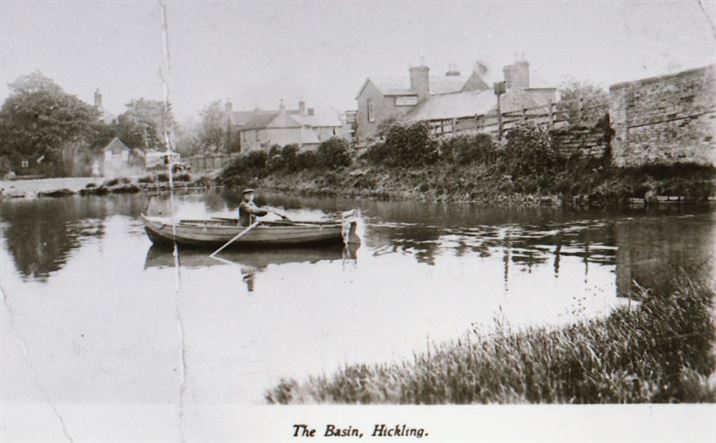
Chapter Four: Nineteenth Century Hickling
There were two pubs in Hickling in 1832, the well established Plough, run by George Hives, who was also a corn dealer. By 1856 there were four public houses, The Plough, The Navigation, The Wheatsheaf and The Wheel. The Navigation had a wharf by the Canal and was next door to the Plough. It was first licensed in [1844 by J Shipman] a farmer farming 119 acres, but by 1853 he was landlord of the Navigation and a wharfinger. Inevitably the Canal brought with it an increased risk of crime and for that reason the village had its own policeman.
At the beginning of the period the secluded agricultural population […]. Knitters struggled on for a few more years but gradually fell into unemployment. For them the canal came as a Godsend, as it provided new opportunities for employment.
The six month old Frederick Maltby, the son of a farmer, was to have an eventful life. At an early age he was taken over to America, where he was adopted by the Warner family. He ended up wealthy and became governor of his State.and is commemorated by the cherry tree opposite the [Church] porch.
In the 1851 census eight surnames survived from the seventeenth century: Daft, Faulks, Hopkinson, Mann and Marriott from the beginning. Edward Collishaw and Paul Hardy arrived soon after. When the Morrises arrived is unclear. It is said that folk in those times married people within a five mile radius of where they lived. This is borne out by wills and marriage licenses of the period. Occasionally, particularly when the couple came from different parishes, they would make a day of it and marry in Nottingham. There were few fashionable marriages which took place in Hickling and such as there were related to the Fisher family.
*[Families could usually t the situation was usually more blurred with many being a bit of each. In the early years of the century, Thomas Cullen of Upton who had eight children was described sometimes as one and sometimes as the other.]
Land was still farmed in the strip system with crops being strictly rotated. Except in the case of more wealthy land owners who measured their land in acres, the commonest measurement was the oxgang which was the amount a man with an ox could plough in one day. Some land had already been enclosed and would probably have been surrounded by hedges. These were called closes and were measured in acres as best could be estimated. The will of John Musson makes it possible to see a similar system in operation. On the wide verges of a mud track isolated cows were tethered to trees. In the towns, more wealthy families would keep a cow on their plots of land.
In the 1970s only seven surnames from the 1851 census survived. Collishaw, Faulks, Herd, Marriott, Murden, Parkes and Woolley. As noted, below, the 1851 populace nearly all came from Nottinghamshire, Leicestershire and neighbouring counties. Perhaps surprisingly, some of the farmers came from further afield. Samuel Marshall came from Leicester, Charles Oxby from Carlton le Moorland, Northampton. More interestingly, a labourer, William Morris’s, sixty year old wife, Mary, is shown in 1851 as having been born in Athlone. It seems likely that she was the daughter of an Irish navvy, but the position is probably more complicated because their 25 year old daughter was born in Dublin. Other wives had come from a considerable distance; Elizabeth, the wife of John Hopkinson, a grocer was born in Cumberland; Hannah Starbuck, another labourer’s wife hailed from Wisbech.
As time went by, what was new became the norm and the character of the village changed. A Wesleyan Chapel was built in 1804 to be replaced by the present building in 1848.
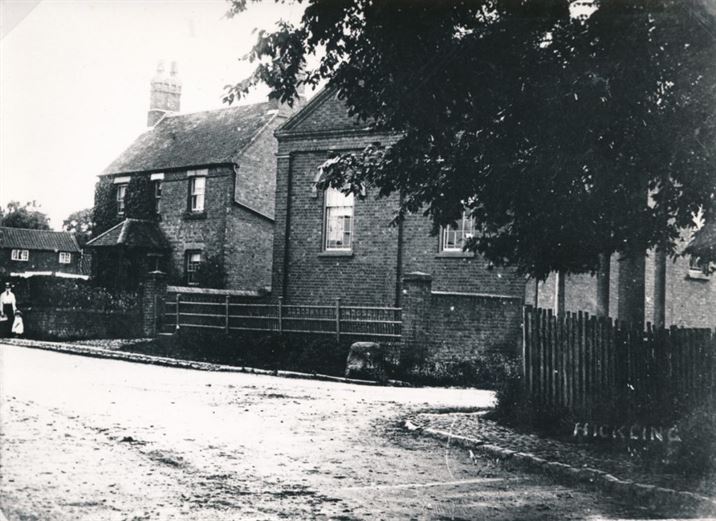
The influx of people brought more awareness of the messages spread by the so-called dissenters. There arose a distinct divide between church and chapel, which was still noticeable three quarters of the way through the twentieth century. The larger population in 1910 shows that their number at the beginning of that book* was not markedly greater than those seventy years later.
There had been some sort of schooling in Hickling since before records began.
1730 Robert Mann left five pounds, the interest on which was to be paid to t61*. There appears to have been no dedicated school house until the present Village Hall, formerly the Church Hall, was built in 1876. A board of school trustees was well established at that time.
[Between 1861 and 1871]*
By 1851 medical knowledge had improved very little. Laughing gas had been discovered but its proponents had been derided and laughed off the scene. Much suffering under the surgeon’s knife and in the dentist’s chair could have been saved. An Austrian doctor had instituted a more hygienic method of delivering babies and the mortality rate of mothers in his ward showed significant reduction. His colleagues showed no inclination to follow his example. Florence Nightingale had brought much improved nursing practices to the casualties of the Crimean War and beer was cheap and plenteous.
The advent of the canal would have made coal much more affordable. Tallow chandlers appear to have largely disappeared from the scene and oil lamps now provided much needed light. Gas lighting had reached the towns.
Travelling could be hazardous. The roads were better and Mcadamised tar had begun to be introduced. Mail coaches and other forms of wheeled transport quite frequently lost wheels or broke down in other ways. Horses sometimes went lame or just died of exhaustion.
My three times great Grandfather, James Smith, a joiner and Baptist and lay preacher, travelled around on his nag and sometimes his grandson, James Granger, used to sit behind him adding to the weight his steed had to bear. Later, he was entrusted with missions by his grandfather and he recounted on one occasion being sent to Kirkby Woodhouse with the half yearly annuity of an elderly former house keeper of his deceased great uncle. He had started early because of the long distance he had to go and the road was empty to begin with. He later recalled how nervous he had been when a stranger was walking in the other direction. Fortunately, he was harmless.
*[age old methods of ener in the century …]
Hickling had a cricket team and football was soon to become popular.
Six people are described as paupers in the 1851 census and Hickling’s oldest inhabitant, a ninety one year old lady was on Parish relief. Others might already have been dispatched to the nearest workhouse. A poor rate […] households were discharged by certificate from paying hearth tax. The overseer of the poor had to raise the tax from members of the village and occasionally those departing this life would salve their consciences by leaving a small legacy to be distributed amongst the poor. A poor box was placed in the church in 1688 by the then church wardens, Henry Faux who married Elizabeth Stephenson at Hickling on 4 June 1683 and Richard Brown. whose initials appear on it. Andersons Charity provided bread for the poor from the 1840s. In 1928 nine people received loaves and in 1934 sixteen, reducing to thirteen in 1939 who each received three loaves. In 1955 there were twelve recipients and finally in 1967 six.
Nineteenth Century Childhood
Little had changed from earlier times, babies were well clad and boys tended to be naughtier than girls. More families could afford a nanny. Toys became more sophisticated. Musical boxes charmed babies to sleep. Much to the chagrin of some, schooling became nigh on compulsory and education became more formal. Endless learning by rote and recitals of tables were enough to deter most children. If you misbehaved you had the prospect of one hundred lines or five hundred lines or “I must not ……….”. Better off families dressed their children beautifully but they did not look forward to their comeuppance when they erred from the straight and narrow.
New Nursery Rhymes were added to the repertoire as more public figures were ridiculed. “The Grand old Duke of York” was Prince Francis Frederick, Duke of York and Albany, the second son of George II. He led a painstakingly slowly prepared attack on the French Republic’s conquests on Flanders and the hill was the city of Cassell which is on a hill about 176 feet high. Other people have suggested two locations in Suffolk near the Arm barracks but they do not seem to fit. Napoleon was the bogey man and is ridiculed in “Boney was a Warrior”
Chapter Five: War
What better way to end this section than to deal with war.
At the turn of the century, Wellington was in the midst of his campaigns against Napoleon. In 1812 we were to have Waterloo. For a quarter of a century we had peace. The brutalities of war had sunk into our psyches but, as soon as a generation of politicians with no direct experience of war takes over the reins of power, all is forgotten and the lust for glory returns. While wars were being waged in such distant places as India, they barely reached the pages of the Newspapers. And so came the Crimean War and the Charge of the Light Brigade so memorably recounted by Alfred Lord Tennison. The Franco Prussian War did not concern us especially with Queen Victoria’s son in law, Freidrich, being heir to the Prussian throne.
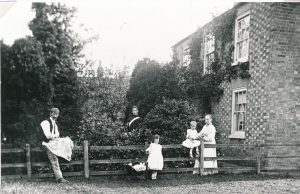
The century ended with the Boer War. An unnecessary war and a gruelling one, with the British forces being besieged in Mafeking and fought at Ladysmith. Many lives were lost. Others were injured, some harpooned by Zulu spears. The effect of it on the common soldier is epitomised by Rudyard Kipling;s words for the marching song: “Boots, boots, boots, marching up and down again.”
Winston Churchill got a taste of war, a most important experience for a wartime Prime Minister. Baden-Powell got his ideas for the Boy Scout Movement.
Within a mere fourteen years of 1900, we were embroiled in the bloodiest war of all, the first off two great wars to dominate the 20th century.
We were soon singing cheerily but warily in the belief that it would be all over by Christmas:
“Brother Bertie went away, to do his bit the other day,
With a smile on his lips and his lieutenant’ pips on his shoulder bright and gay.
As the train moved away, he said: Remember me to all the girls
And then he wagged his paw and went away to war, shouting out these pathetic words
Good bye-ee, good bye-ee, wipe the tears, baby dear, from your eye-ee,
Though it’s hard to part you know, I’ll be tickled to death to go.
Don’t cry-ee, don’t sigh-ee, there’s a silver lining in the sky-ee,
Bonsoir old thing, Cheerio, Chin chin, napoo, toodle-oo, good by-ee”
And soon:
“The bells of hell went ting-a-ling-a-ling for you but not for me,
and the little devils went sing-a-ling for you and not for me,
Oh, death where is thy sting-a-ling-a-ling,
Oh grave thy victory,
the bells of hell go ting-a-ling-a-ling for you but not for me”
And men were matching to the tune of:
“Goodbye, Dolly, I must leave you,
Though it breaks my heart to go,
Something tells me that I am needed,
At the front to fight the foe,
See- the boys in blue are marching, And I can no longer stay
Hark – I hear the bugle calling.
Goodbye Dolly Grey”.
Men in their hundreds of thousands died in the appalling conditions of the trenches. More and more men were being sent to Flanders and the Somme as cannon fodder. Many showed immense bravery, the few who waivered and deserted were mercilessly shot at dawn, even though they were shell shocked or had just been spattered with their best pal’s blood guts and brains For some, a brief respite from “Wipers” would find solace in the arms of “Sweet Lilli Marleine” and they would come home for short leave. The more fortunate were sent home with minor injuries and would have a more extensive period of recuperation.
For those at home, the daily fear of receiving a knock on the door and a telegram would have been as agonising as the fond farewells.
Hickling lost seven men who were killed in the war and Stumpy Watchorne lost a leg. A photo of him, standing up on his boat on the Basin, hangs in the Villagers’ bar at the Plough.
It is impossible in retrospect to express the sentiments of the village people in those days but we are indeed fortunate to have the writings of Francis Ashmall, the Rector of those days whose words so eloquently express the feelings of ordinary people of that age. These are to be found in the final pages of this book.
The vengeance meted out to the Germans at Versailles was too harsh. They were deprived of their industrial power base in the Alsace and the reparations which they were forced to pay were crippling and led to recession and demotivation and in due course Hitler came to power. The consequences were horrific.
Soldiers sang as they marched along:
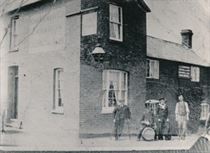
“Hitler has only got one ball,,
Goering has two but very small,
Himmler is very similar.
And poor old Goebbels has none at all”.
… and many variants of this.
For forty years, we had the cold war and when we thought we were past war, we had Iraq and Afghanistan.
“When will they ever learn”
Chapter Six: The Church and Churchyard
Early History.
Domesday Book carries no record of Hickling having had a church but there must have been a place of worship ever since the Vikings came in their high prowed ships and wielded their battle axes. During the course of their rampage, they pillaged the land and they must have conquered such places. Otherwise, our neighbouring villages would not be named Harby, Granby or Wartnaby. Anglo Saxon and Viking relics have been found all over the area. The sarcophagus which now lies in the porch bears both pagan and Christian symbols in the hope of appeasing whichever God he would find presiding at the Judgement Day. This is evidence of a Viking settlement.
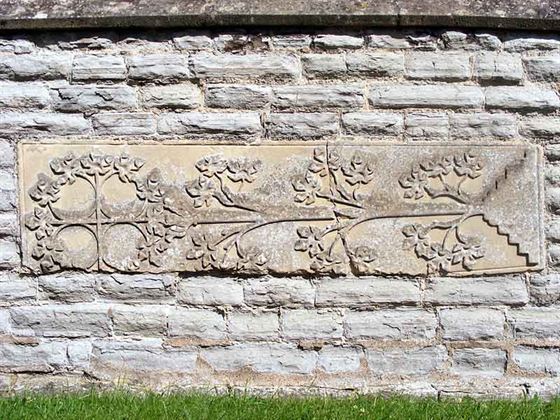
*Diligent monks would have been welcomed into the villages by the more devout-natured, trusting the missionary monks who would gradually weadle their way in [despite] their, at times, fearsome menfolk. Another sarcophagus can be found built on to the tower. This one however had a simple Cross, though this more likely dates back to Anglo Saxon days.
According to pre-reformation wills, Hickling church was dedicated to St Wilfrid. Orton’s Thesaurus of 1763 says that “it comprises a nave, North and South aisles, South porch, chancel and Western tower. The fabric measures internally 21ft 2″, in length of nave 47ft 8″, width of nave 21ft 2’”, width of North aisle 10ft, width of South aisle 18ft 9”, length of chancel 41ft 3, “width 15ft 2”. The tower is 10ft 9″ square inside.
The only differences today are that the chancel is Victorian Gothic rather than Early English, the tower looks as though it was built one hundred and forty years ago, which it was, and the weather vane has recently been moved from the centre to the side of the roof of the tower. The clock will have looked different, having been replaced in 1890 by one made by Smiths of Derby. In 1835, Robert Story, a Yorkshire man of peasant stock wrote
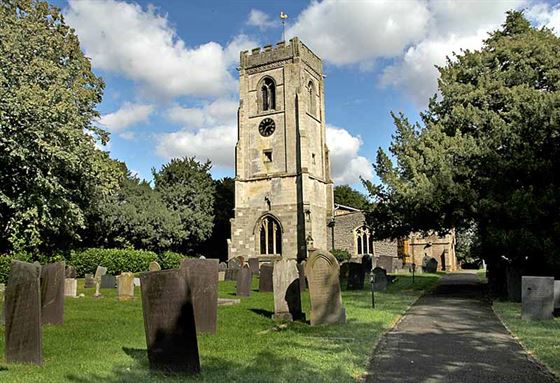
“Encircled by trees in the Sabbath’s calm smile
The church of our fathers, how meekly lies
Oh villagers, gaze on the hallowed pile
It was dear to their hearts, it was raised by their hands
The love’s not the place where they worshiped their God
The love’s not the ground where their ashes repose
Dear even the daisy which blooms on the sod
Dear is the dust out of which it arose”
A “sketch” of the church, which probably dates back to about 1900, is:
“The nave arcade is Early English work of four bays, the pointed arches of to orders of chamfers (bevels), being supported by octagonal pillars with moulded caps and bases.
“The clerestory contains four plain oblong windows of three lights each on either side. The roof, formerly high pitched as indicated on the East wall of the tower, is constructed of massive timbers and covered with lead which on 1 November 1887 was stripped off during a heavy Southerly gale. The aisles, which are of the Early English period, and the supported diagonal buttresses are built of local limestone in narrow courses except the buttresses and East wall of the South aisle which appear to have been rebuilt of a yellowish stone in 1736. The roofs of low pitch are covered with lead. The West wall of the North aisle is partitioned off for use as a vestry. At this end is a plain oak chest on the front of which the date 1815 is cut. The Eastern side is occupied by an organ. The wall which carries two Decorated windows being plastered in this aisle except for a small slab of stone which projects from the South east aisle and which may be the Paschal for the Virgin or patron saint referred to by Stretton”.
Stretton wrote:
“The plain rectangular font is of about the date of the Reformation when the old fonts were restored. The chancel is spacious and has two light windows an a three light East window with O G heads and tracery but the latter is bricked up for the admission of a modern altar piece of great merit. The railing, steps and stones of consequences with border inscriptions worn out are good and neat. In the chancel, lying on the floor, is a singularly curious Danish grave stone, coffin shaped and roofed which probably has been in the lid of a stone coffin. It was dug up in the churchyard many years since, in making a grave. On the edges it is about four or five inches thick and in that part it is eighteen inches wide. Over the breast is a cross patee surmounted by a shaft running from the bottom to he centre, the sides, top an ends are divided into compartments with runic knots and allegorical figures like the ancient crosses still standing in some church yards in this country”.
Memorials and Features.
The Bryceson organ was installed in 1840 and overhauled in 1936 and again in the latter half of the twentieth century.
Over the last century virtually nothing has even changed its position in the church. The chest has moved from the North aisle to in front of the back pews on the left facing the altar. The sarcophagus was stood on its end near the Paschal stone in the South aisle and most regrettably this caused it to crack top to bottom. This has now been expertly repaired but the crack is all too plain to see. It now lies on the North side of the chancel between the choir stalls and the altar. Opposite it lies the Vaux tomb stone which commemorates the death of Baron Vaux of Harrowden but more of this later.
This was William Vaux, 3rd Baron Vaux of Harrowden. He was a Catholic and was several times convicted of recusancy in the reign of Queen Elizabeth. He was committed to Fleet Prison by the Privy Council and tried in the Star Chamber in 1581 along with Sir Thomas Tresham for harbouring the Jesuit, Edward Campion, and contempt of Court. He was sent to prison and fined £1,000. He died in 1595.
On either side of the chancel are the memorials to eighteenth and nineteenth century rectors and a plaque commemorating the rebuilding of the chancel. There is a piscina on the South side of the chancel in front of the altar and another one in the South aisle, giving the impression with its Paschal Stone of having once been a private chapel. On the floor, being worn away by feet are the Babington brass and the worn grave stones of Francis Bedford and Richard Coke, respectively rector and curate who died in 1716 and 1724.
The Royal Coats of Arms and that of Queens’ College, Cambridge in the tower have recently been restored thanks to the efforts of Commander Rawlinson, lately deceased, and Rosemary, is wife. They are now resplendent in their glory. Would that a more prominent place could be found for them in order to show off their true magnificence.
A brass plaque to Primrose March who died in 1934 adorns the wall of the South aisle. She was killed by a vehicle on the A606.
At the North end of the main church door, a place has been partitioned off to form a kitchen and a separate disabled toilet. A table stands in front of it for serving coffee and biscuits and on high days and holidays, wine. The font is further back. It dates back to Richard II’s reign, 1337-1399 but it was restored in the 1840s.
The knob on the top of the font will have been made by the village carpenter in the first half of the seventeenth century. This may have been Thomas Wilson.
The pews are Victorian and regrettably those in the South aisle have recently been removed. A letter to a newspaper by a Mr E W Bell who was a boy in the 1870s recalls a swarm of bees flying in during a service and landing on a maiden lady’s hat. She had the peace of mind to take her hat off and set it down beside her and continued singing the hymn unperturbed. The pew was a box pew and this dates the pews back to about 1880. The box pews had probably been fitted in the seventeenth century. Prior to that the wealthier parishioners provided their own seats. Harry Huston, who died in 1587, left two shillings in his will for the repairing or remaking his desk in the church.
On either side of the bridal path stand the church wardens’ wands. A rather fanciful notion of Peter Harrison’s. It is hard to imagine swarthy wardens of yore waving these fairy wands. It was difficult for me to hold it while propelling my wheel chair. There is an old coffer in front of the vestry. This probably dates back to the 17th century and may also have been made by Thomas Wilson.
The poor box is dated 1686 and bears the initials HF and RB. These initials on stand for Richard Blower, who was one of the church wardens that year and a carpenter by trade, and Henry Faulks, who was the only person in the village with those initials.
In the tower hangs the list of legacies to the church and towards the provision of a schoolmaster. It is surprising that of all the various bequests only William Westby’s ten pound legacy survives of the perhaps £300 overall. Has there been a massive fraud here?
Above is the belfry, with bats to boot, and there resides the pride of bells. In 1935 the clashing of bells was too much for the delicate ears of either the Rev or Mrs Foster and the louvres in the belfry were half boarded up. In the 1980s and 1990s a concerted effort at fund raising by a dedicated team of bell ringers and their supporters secured the money to increase the number of bells to a full peel. This funding also paid for a new bell frame. The bells are:-
A treble number 1 was brought from Kinoulton church in 1987 and there is a sanctus bell which is of late18th century origins. What happened to the earlier one, mentioned in the inventory of 1550 is a mystery.
The earliest gravestone in the churchyard is that of [?] Shittlewod who died […] 1680. Hers is in the two rows just South East of the porch. They are squarely rectangular and made of slate.
In about 1700 a local craftsman started carving gravestones in slate with beautiful angel heads with long curled tresses.
The gravestone of John Smith of Cropwell Bishop has this quaint epitaph:
“In the year of our Lord 25 in a heart Here lyeth the body of John Smith of Cropwell, who died Dec 23d in the 74th year of his age
“This world’s a city full of crooked streets
Death is ye market place where all men meets
If life were merchandise yt men col’d buy
The rich would often live and the poor men die”
In the eighteenth century it was the habit of the youth of the village to hang around the churchyard, much as they now do in the towns and larger villages on the street corners. As today, they sometimes felt like getting up to no good. Freed of puritan shackles they would get up to mischief. All traces of this have long since disappeared but this was with the exception of the carvings on the ancient church door.
The most prominent of these miscreants were PH 1730 (Paul Hardy), RC, JC and WC (Robert, John and William Collishaw), who would later become most respected members of the community.
The others were:
The majority of these attributions are accurate. I have no evidence for a relationship between a William Morris and an Isabel Daft but sweethearts do not always marry and William may have regretted his youthful folly. The Ms are inevitably speculative.
William Walker, late rector of this parish died in 1857 and was buried near to the chancel on the South side and just beside a yew tree on what appears to be a grave. Perhaps he lives on in the tree and he lives on in that hallowed tree by courtesy of Ganesh, the true God.
Chapter Seven: The Value of the Church and its Living
Taxation
The Taxation of Pope Nicholas IV (1291) gives the clear annual value of twenty pounds a year. The portion of St Mary’s Abbey in York was one pound six shillings and eight pence and the portion of Adam de Petton a similar amount. The remainder was the rector’s income and would have allowed him to live comfortably.
According tp the Valor Ecclesiasticus of Henry VIII, the rectory of “Hyklyng” was valued at the yearly sum of sixty pounds five and two pence. John Bayle was the Rector and an annual pension of one pound six and eight.
According to the official survey taken before the suppression of the chantries; “The parishe church of Hycklen ys worthe by the yere in the increase in certaine Stockes of money to the some of xis Remayning in Divers mens hands and occupying. Graunted for the mayntayning of certaine “Lampes and Lightes for ever there xixs.”
This was extracted from Certificates or Chantries roll 27 number 2. A chantry was either a private chapel built on a rich man’s ground or a priest or group of up to ten priests whose function was to sing masses for the souls of the dead.
The inventory of the church goods drawn up in the reign of Edward VI contains the following entry relating to Hickling:
“These are the goods of the churche of Hikling one chalice of silver with the patent of the same con corprasse withe Crosse ii alar clothes ii fanelled ii candelstiks of brase ii albes ii amyasse ii stools ii fanelles ii vestments one of white bustyan the oyr of green silk ii Coopes of green silke a canapy of brasse the pix pf brasse a Cross of Woods in ameld the coths of lynyn ii surplised one for the priest and another for the Clarke con crisseory of brasse ii cruett of pewdr of haly water cave of brasse i shete of linyn ii bane cloths iii bells and a sanctus bell two hand bells ii pillowes covered wt green silke one pyx of latten
Sir John Belby the parson
George Welles
Lawrence James ChurchMasters Raufe Pilkington
Thomas Man pro ye towne
The Commissioner of Church Goods on 16th May1552 handed over to:
“John Bayley, parson, William Staplaton and Raufe Patchynggam, church wardens. One chalis of siluer wt a patynne of siluer also to the same for th’administration of the holly comunionin ye same churche as also ii belles and a saunct bellhanginge in ye Steple of the same church.”
The Parliamentary Commissioners in 1650 reported, “Alsoe the Rectory or Parsonage of Hicklinge which is worth one hundred and three score pounds per annum (sequestered from Doctor Bardsey) to the State’s use John Rocket Clerk the present Incumbent who hath the cure of soulse and diligentlie supplies the cure in his owne person beinge a “preachinge Minister”.
The worth of the Rectory to the King in Mr Leake’s time was £22
In about 1660 it was only worth £18.8s.4d.
In the 1780s the Archbishop was entitled to four shillings, the Archdeacon seven shillings and sixpence and Queens’ College £1.6s.4d. Robert Barker’s tithes as Rector amounted to £1.16s.10d and the King’s worth was unchanged.
On 13 June 1825, a terrier was prepared detailing the church property:
The Furniture of the Church and Chancel
Books
Vestments
Vessels
Chapter 8: The Rectory
From the time of the appointment of the first priest, there must have been a house for him to live. As younger sons of gentry they would soon have been demanding accommodation which befitted a man of their status. it would, of necessity, have been close to the church and probably would have been close to the church.
Due to the difficulties of travel in the early days, most of the rectors would have lived there, though even as early as 1320, Adam de Preston had the wanderlust and others may have had sinecures and clerical duties to be performed elsewhere. It is not until the 17th century that a clear picture emerges. Richard Snowden was already comfortably ensconced in the Rectory at Widmerpool and Edmund Bardsey was also rector of his home village. James, his nephew, would have spent some time there in his short period of office but his uncle’s stinginess would have restricted any prettification to the bare necessities and to the bare minimum and John Rockett was there upon sufferance until another nephew could step into his shoes.
So, it was not until the arrival of George Fisher that any attention would have been given to the fabric and the decoration of the old homestead. George Fisher was born into a wealthy family of Grantham burgesses and would have been used to living in some style. He was a warm-hearted soul who liked entertaining and his creature comforts. In 1664 he paid tax on six hearths and (?) in 1674, though this would not have been caused by any addition to the buildings but by the victory of the needs of the body over the needs of the purse. Hastily blocked up fireplace would have been unblocked in common with a large number of houses up and down the country, jobbing builders plenty of employment.
George lived to a ripe old age and with age comes neglect. Francis Bedford who replaced George in 1716 was already old beyond his time and would have been happy to live anywhere warm. His successor, Nicholas Penny, did not deign to live there and bought a house of his own and it was only when John Warde arrived that anything was done. He probably leased Nicholas’s house to start with but despite his limited means started rebuilding the Rectory in 1735.
Chapter Nine: Christianity
This section is intended to explain how the appearance of the inside of the church building and church services developed over the centuries. Those who do not want their faith confronted with controversial arguments should not read it.
The Early Church & Creation Myths
As soon as Nomads and hunter gatherers settled down into communities and even before that they would have begun asking questions about why misfortune struck and what would happen when they died and, much later, how did the earth begin. They also needed to draft a code of living to ensure that their people behaved in an acceptable way. The early Jews did this through the ten commandments and later pronouncements. They told of heaven and hell and what would happen to if the strayed from the norm by way of both heavenly and earthly retribution.
The Greek’s had the laws of [Draco? Draconian?]* and told their peoples of how, when they died, they would have to carry an obol in their mouth to pay Charon for ferrying them over the River Styx to the Elysian Fields. There they would either find Elysium or be thrust into the fiery flames of Hell. The Chinese had the teachings of Confucius which they still read today. All nations from the Aztecs in Mexico to the Zulus in South Africa had their own ideas of the creation and what happened when they died and their own codes of behaviour and sets of beliefs.
Many of the stories passed down to us from the early books of the Old Testament originated in other Middle Eastern cultures from the time when the Israelites were captives in Babylon.
All cultures had their Creation stories and a Hindu one bears remarkable similarities to ours:
“Before time began there was no heaven, no earth and no space between. A vast dark ocean washed upon the shores of nothingness and licked the edges of night. A giant cobra floated on the waters. Asleep within its endless coils lay the Lord Vishnu. He was watched over by the mighty serpent. Everything was so peaceful and silent that Vishnu slept undisturbed by dreams or motion.
From the depths a humming sound began to tremble, Om. It grew and spread, filling the emptiness and throbbing with energy. The night had ended. Vishnu awoke. As the dawn began to break, from Vishnu’s navel grew a magnificent lotus flower. In the middle of the blossom sat Vishnu’s servant, Brahma. He awaited the Lord’s command.
Vishnu spoke to his servant: ‘It is time to begin’. Brahma bowed. Vishnu commanded, ‘Create the World’.
A wind swept up the waters. Vishnu and the serpent vanished. Brahma remained in the lotus flower, floating and tossing on the sea. He lifted up his arms and calmed the wind and ocean. Then Brahma split the waters in three. He stretched one part into the heavens. He made another part the earth. With the third part he created the skies.
The earth was bare. Brahma set to work. He created grass, flowers, trees and plants of all kinds. To these he gave feeling. Next he created the animals and the insects that live on the land. He made birds to fly in the skies and fish to swim in the waters. To all these creatures he gave the senses of touch and smell. He gave them power to see, smell and move.
The world was soon bristling with life and the aie was filled with the sound of Brond of Brahma’s creatures”
(As described on the internet by Painsley Organisation.)
Flood stories abound, They include the Sumerian and the Babylonian Epic of Gilgamesh but there were flood myths from places as far apart as China and [*…].
I have no problem with the Books of the Old Testament from Isaiah onwards nor the four Gospels, the first part of the Acts of the Apostles but I have severe doubts about Saul’s Damascene conversion and what he embroidered onto Jesus’s simple teachings.
Jesus was a clear sighted man and even at the early age of fourteen threw the money lenders and usurers out of the temple and quickly saw through the hypocrisy of the Pharisees and Saducees.
His teachings gave us a simple creed to live by: “Love God and love thy neighbour as yourself. If a man strikes you on the cheek, turn the other cheek. He told us other principles to guide by way of parables; that it is wrong to cheat our masters, that you will only be forgiven for your sins if you truly repent. About the Good Samaritan. That it is easier for a camel to go through the eye of a needle than for a rich man to go to heaven. Jesus was preaching to the Jews as the son of their God and probably never thought of converting the gentiles.
St Paul was a rabid opponent of Christianity who claimed that he had had a Damascene conversion. But how can we be sure that his conversion was not part of a plan to usurp Christ’ teachings to his own devices, a wolf in sheep’s clothing. The Apostles would have been very gullible, having witnessed so many miracles, the Resurrection and speaking tongues, and would have welcomed any friend into their midst. They would have been susceptible to the blandishments of a false prophet. To this day powerful men are quite capable of failing to recognise false prophets or even the AntiChrist.
This is sheer speculation from someone who prefers Christ’s Gospels unadulterated but it goes to demonstrate how dangerous it can be to accept blindly a dogma, whether religious or whether economic. This is not to suggest that St Paul was not a holy man nor that all his teachings were wrong.
Both St Peter and St Paul came with their followers to Rome. As might be expected, there were differences of opinion between the two sets of followers and, when the texts were chosen for the New Testament, it comprised the four Gospels, the first half of the Acts of the Apostles, Revelations and a couple of Epistles of St Peter. It was packed with Paul-ine texts. It would, surely, have been enhanced by the Gospel According to St Thomas and Tobias and the Angel. Other texts were excluded because the tell a slightly different message to that given in the New Testament. The motives behind these exclusions remain veiled in the history of time.
Even from the first century after Christ’s death some prominent Christians started to revere Christ’s mother.
Constantine was the Roman Emperor in the East based on Istambul or as it was then known as Byzantium. He was not pleased when his wife became a Christian, but when he realized the power of the Cross as a banner to march behind, he soon saw the Light. From then on Christianity has been a warlike religion. “Onward Christian Soldiers, marching on to war, with the Cross of Jesus, flying on before”. Constantine’s successes soon made Christianity the most powerful religion in the Western world and with that came immense power to its leaders.
Their mission was to spread the faith, and in order to do that, they were prepared to use force or help those of other beliefs to convert by bringing aspects of the customs of those other faiths into their catholic religions.
Conflicts over doctrine and the interpretation of the Gospels inevitably arose. Arius who lived in Alexandria between 250 and 366 AD taught that Jesus was a created being and perhaps inferior to God, the Father and that they did not exist together eternally. This was based on the Scriptures for example: John 14.28 in which Jesus said “the Father is greater than I” and John 17.20 to 26, where Jesus asked the Apostles to become “one as we are one”. Thus, demonstrating that the oneness is not physical but purely spiritual.
The problem for the Church in Rome was that this was a logical interpretation of these words. This was the first major controversy to hit the Christian Church. It spread throughout Christendom over the next century and a half and found its adherents among all walks of life from layman to bishop. The whole matter was discussed at the Council of Nicea from which the present day Nicean Creed derives. Arian-ism was declared a heresy and only three of some three hundred bishops declined to sign. This was quite possibly more out of a feeling of need to show the strength of unity or the fear of the consequences of being branded a heretic than any deep convictions. Strict matters of interpretation are not the be all and end all of life.
At about the same time another heresy, Manichaeism, was rife. It was a quintessentially dualistic religion and was based on the writings of Mani who lived in Babylon from 210 to 276 AD. Its core beliefs were that there is no omnipotent power of good and that there were two equal and opposite powers of good and evil. These fought over man’s good soul and evil body. All matter was evil and man could only save himself by identifying himself with his soul.
Manichaeism found favour with the Persian king who encouraged its spread throughout his empire. His successor, however, did not share his sympathies and persecuted Mani’s followers. Manichaeism was declared a heresy by the Christians. They passed on the word in the meantime and found adherents over a wide area. They were particularly strong in South Western France.
Gnosticism refers to belief systems found in Europe and the Middle East, some of which may have had their own separate evolutions. In simple terms its teachings are of the human soul which is divine but trapped in an evil material world created by an imperfect God, the demiurge.
The demiurge was sometimes thought to be imperfect but benevolent and in other cases wholly evil. He was believed to exist alongside a remote and unknowable supreme being that embodied good. In order to escape from the evil world it was necessary to get to know this Supreme Being. Christ comes into this picture either in the guise of the embodiment of the Supreme Being made incarnate or a false prophet.
Gnosticism attracted many followers and may even have been suppressed in Judaea before the time of Christ and the Church took little time to declare it a heresy. This did not stop it from spreading throughout the Roman and Persian empires. The rise of Islam and conversion to its doctrines and the Albigensian Crusade reduced its numbers to a mere shadow of what they were.
The Paulician heresy flourished between 650 and 875 AD. The Paulicians had Manichaean and Gnostic beliefs but they accepted the four Gospels, The Acts of the Apostles, St Paul’s Epistles and those of Saints John, James and Jude but rejected the Old Testament and the Cult of Marianism. They believed that Christ came down from heaven to rescue man from the body and the world which they regarded as evil. They also rejected the Sacraments and Christian baptism.
The sect had Middle Eastern origins and soon came to the notice of the Church authorities in both Rome and Byzantium and early leaders were stoned to death. Despite internecine struggles within the sect and persecution, it grew in power and formed armies for its defence. Its armies grew powerful and it had adherents throughout the Middle East. It is said that the Paulicians lost a hundred thousand lives in their wars against the Emperor of Byzantium. Eventually, they were defeated in 872 and the survivors migrated to Eastern Europe where they were tolerated. Over the centuries their numbers dwindled but a few pockets survived into the early nineteenth century.
But it was gnosticism and dualism that continued to influence peoples’ thoughts. The ideas of an omnipotent God and there being no power of evil are difficult for unsophisticated human beings to conceive and it is not surprising that there are elements of these in most future heresies.
Over the years power bred wealth and they persuaded the rich that they could buy their way into heaven could be obtained by way of gifts to the Church. Vast tracts of land were acquired in this way. Troublesome daughters were sent to a nunnery
Later on they thought up the idea of selling indulgences.
There must have been some form of church or meeting house in Hickling ever since the introduction of Christianity to the village. The Anglo Saxon sarcophagus which now lies in the chancel indicates that some of its earliest inhabitants has not been fully converted to the faith.
The Domesday book of 1066 does not record that “Echeling” had a priest or a church.
It seems probable that the rectors and vicars in the pre-Norman church were largely drawn from the younger sons of the gentry with curates and lesser officials drawn from humbler origins. After the conquest the position would have remained similar but the gentry were now predominantly Norman. The right to appoint incumbents to benefices was generally held by powerful local gentry and they would sponsor particular priests or accept payment from families for a living for a younger son. The glebe rents, tithes and Easter offerings would afford most of them a comfortable life while allowing the family wealth to pass down relatively unscathed.
Early Mediaeval Heresy
The Lord thy God is a jealous god. Nothing like so jealous as his representatives on earth. They were greedy for power and avaricious for wealth. They would not tolerate anyone having the smallest doctrinal differences to themselves. Such people they hounded and persecuted to the grave. They did not hesitate to apply the most savage and brutal interrogation techniques and were experts in the arts of torture.
In 1209 the Catholic Church initiated a campaign to rid themselves of the Cathar heresy in the Languedoc. This was the first major heresy in the view of its leaders for a thousand years. They were a simple peace loving people whose lives were involved in small farming and sheep droving and the various industries which converted their produce into the food which they ate and the clothes which they wore. Their everyday lives are vividly portrayed in “Montaillou”, the account of their persecution by the Bishop of Toulouse who was in charge of their persecution. They had simple beliefs and were happy to accept Christ’s Gospels but would not subscribe to the Catholic Confession.
What particularly annoyed the Catholic leaders, apart from their obduracy, was their gnostic and dualist beliefs. The believed that there were two Gods, one good and one bad.
Church Services
Going to church would have been a very different experience from today. In Norman times and up until the Reformation the churches would have had few seats for the general population apart from in some churches the benches jutting out from the wall, giving rise to the saying “the weakest go to the wall”. In the dark the church would be lit with candles and heated with braziers. The purveying and heavy scent of incense would have ameliorated a little the odours coming from their equally unwashed fellow beings, while intoxicating everybody with a feeling varying from drunkenness to indolence. Plainsong would have been sung. The overwhelming envelopment and sense of awe which emanates from the sung mass with its organ and the singing of the choir and congregation could easily turn an atheist into a firm believer, if exposed long enough. The three surviving examples of painted churches in England are at Wenhaston in Suffolk, St Thomas in Salisbury and St Trinity in Coventry. In Hickling, vestiges of the old paint including lozenges and diagonals are visible in the rafters in the front end of the nave.
From the earliest times, Christians have sung psalms, hymns and spiritual songs, both in private devotions and collective worship.
Matthew 26:30 – “And when they had sung an hymn, they went out into the mount of Olives.”
What they would have sounded like is impossible for us to know but the characteristic demi and semitones would have been prevalent and Hebrew is a gutteral language. Supplications to Jehovah would have sounded like wailing.
By Norman times Gregorian chant or plainsong, sung in unison, was resonating our cathedrals and churches and their simple scores in full notes and minims remain with us today. Stringed instruments such as the harp and lute were sometimes used as accompaniments. A favourite early hymn was “Of your Father’s Heart Begotten” which sung to the plainsong melody “Divinum”.
Later hymnody used four-part vocal harmony incorporating major and minor keys. This developed over the centuries into the rich overwhelming sound of the organ and massed choirs which still on occasion floods our cathedrals.
It is uncertain when St Wilfred’s acquired its first organ but it would surprise me if there has been one in position for five hundred years.
Nothing much changed immediately with the coming of the Anglican church following Henry VIII’s divorce from Anne Boleyn except that the services were held in English, the Bible was read and the incense and bells were done away with. Corrupt practices such as the selling of indulgences were put to an end.
As everyone knows, Henry VIII blamed his wife for his lack of y chromosomes and sought a divorce from Katherine of Aragon. Thomas Cranmer was the then Archbishop of Canterbury and he helped Henry to build a convincing case for his divorce. He established the first doctrinal and liturgical structure of the Church of England but did not make many radical changes in the church due to power struggles between religious conservatives and reformers. He did, however, publish the first officially authorised vernacular service and wrote the first Book of Common Prayer. He suffered the fate of most of the leaders of the Church of England and was executed under Queen Mary.
The reformation blew a fresh breeze through our churches and Martin Luther’s deep conviction. It is to him that we must pass our thanks for such hymns as “Ein Feste Burg”.
The accession of Queen Mary had a dramatic effect, the Roman Catholic services and practices returned. The leaders of the protestant church were tortured and burnt at the stake. Her reign was very short and soon the Anglican practices returned. Revenge was swiftly extracted, Catholic leaders were quickly burnt and a witch hunt was vigorously pursued. Many aristocratic and landed families stuck fast to their Catholic faith. and sought means of hiding their priests. They built tunnels and made priest holes and secret staircases to conceal them. The yeomanry, the artisans and peasants were all for peace and quiet and did not mind too much whether their services were in Latin or English. They meekly accepted what was served up to them. Just a few stuck strongly to their faith and they were hounded down like criminals being brought the Ecclesiastical Court on grounds of being papists. In a few extreme cases, they appeared before more powerful courts and some were even executed.
Under James I and more particularly under Charles I and their supporters, church services had to be full of ceremony and contain harmonious liturgy which were epitomised by Archbishop Laud’s teachings. This was loathed by Puritans who regarded it as close to Catholicism. During his eleven year period of personal rule, Charles sought to enforce unity throughout his kingdom much to the chagrin of those of any shade of puritan opinion. William Laud was intolerant of any kind of opposition and did not hesitate to use the Star Chamber and High Commission to inflict savage punishment on his critics. In 1637 the religious radicals, William Prynne, Henry Burton and John Bastwick were imprisoned and tortured for speaking and rabble rousing and “Freeborn John” Lilburne was persecuted in 1638, provoking a popular outcry. By 1641 the tide had turned and Laud was impeached and imprisoned in the Tower of London. He had four long uncomfortable years in the Tower before being beheaded.
The puritans in Cromwell’s times put an end to this. In the most barbaric way they tore down the gargoyles and sculptures, breaking them into pieces. They smashed the stained glass windows and ravaged all coloured walls and whatever they considered idolatrous. The walls were painted white and fire and brimstone was preached. In Hickling, at least, the church would have been brightened by the two large paintings of the Royal Arms, now hanging in the tower, which would have occupied a prominent position in the church in Edmund Bardsey’s days and those of his successors. Rich and poor alike flocked in their droves to church and the churches were bursting with obedient souls but as soon as the Church relaxed they lay in their beds on the Sabbath day. Swine were mucked out and people felt free to sin. Gradually the flamboyance of the reign of Charles II would have filtered down to the provinces and church music became more cheerful. It was as though the vengeful God had changed overnight unto a loving God and it was man’s duty to worship him. How soon this music would have been heard in Hickling would have depended on the receptivity to change of George Fisher who would hold the reins (until 1715). This mood of optimism would hold for another one hundred and fifty years.
The hymn tunes of the eighteenth century rebelled against the puritanical, being lively and even riotous enough to make the rafters ring in true Handelian fashion with blazing trumpets from the gallery, if one there was. The music for “While Shepherds watch” was a prime example. The present day apology for a tune is dreary in comparison perhaps served to fill a few seats in the discouraging emptiness of the naves and aisles. The sermons would drone in above the heads of most of those present. Hambleton in Rutland even employed someone as a waker-upperer. The lower and middle classes experienced a much bleaker form of existence and started flocking to the nonconformist churches that were spreading through the region and their music was much more earnest.
Charles Wesley’s hymns spread Methodist theology into most Protestant churches, bringing to us a new focus on our personal relationship with God.
All good things must come to an end. As usual, they happen slowly. John Wesley brought back a more puritanical tone to services, reflecting the appeal of the non-conformism that was sweeping the country. Charles Wesley’s hymns reintroduced a sense of earnestness to our hymnal. Prince Albert of Saxe Coburg Gotha brought to us such Germanic Customs as the Christmas tree and Christmas card. Germanic hymns such as “Ein Feste Burg”. We must, contrariwise, for ever show our gratitude to Felix Mendelssohn for “Hark the Herald Angels Sing”. He also brought with him such Germanic Christian names as Alfred, Ernest, Adelaide and Gertrude came too. By the middle of Victoria’s reign, missionary zeal was infecting the Church and true to the Emperor Constantine such hymns as “Onward Christian Soldiers” were thumped out on organs everywhere matched by the lusty voices of the people. As in the eighteenth century, they reflected the need to encourage dwindling congregations to return to their pews. Memorable hymns such as “Abide with Me” crept into the English hymnal. It was composed by the Scottish poet, Henry Francis Lyte, just before his death.
Hickling would probably not even have noticed the effect caused by the debates going on in the Church initiated by the Oxford movement. The debates were begun in Oxford in the 1830s by a group of academics which included John Henry Newman, John Keble, Edward Bouverie Pusey, Gerald Manley Hopkins and Henry Edward Manning, were incentivised by the decision of the Government to reduce the number of Irish bishops in the House of Lords to ten. They attacked liberalism in theology and looked at the beliefs of the Church of England and how they related to those of the Church of Rome. Newman, who was later to convert to Catholicising, compared the tenets laid out by the Council of Trent and the thirty nine Articles laid out by the Church of England in its early days.
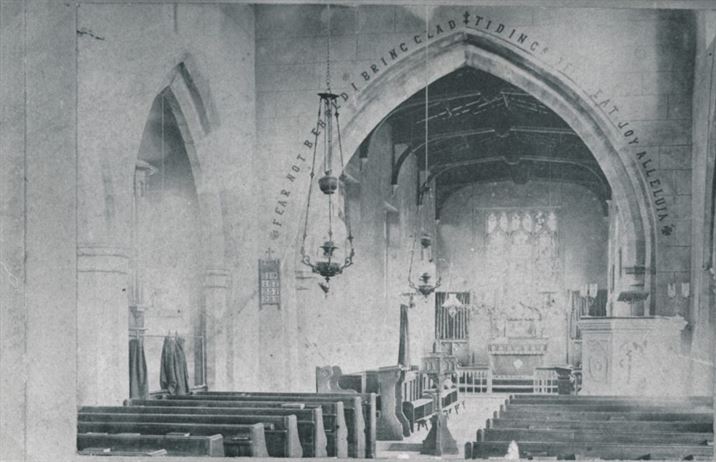
The Anglican Church kept its authority throughout Victorian days despite waning church attendances and again came into its own during the two world wars.
Its authority began to wane in the second half of the 20th century. This must have been caused by some weak leadership, aided and abetted by the power of the Prime Minister’s power to veto those selected by the Church. The advertising boom, imported from America, fuelled a consumer culture and the spread of scientific knowledge made many aware of the incompatibility of Darwinism and the Creation Story from Genesis. Militant atheists and humanists spread further doubts among thinking people. Then came Margaret Thatcher on the scene, encouraging us all to think of ourselves first and to lust over private wealth. This developed us into an uncaring and unequal society where dog eats dog. She selected George Carey as Archbishop of Canterbury. He was good at sorting out the Church’s finances which were sorely depleted after its property advisors had lost a fortune through unwise dealings. We were later told that the losses had been restored by way of wise dealings, but this was in the next property boom and, surely, the value would have been far greater if they had started with the undiminished pot rather than what they did. I, personally, believe that a more outwardly holy man would have been more inspiring.
Also, the Church has changed its message. This seems to be: God is a loving God and, if you become newly reborn as a Christian and repent of your sins, you will be one of the Chosen and be sure to go to heaven. All is forgotten about the Day of Judgement and what happens if you are not allowed through the Pearly Gates. All is forgotten about, “It is easier for a camel to pass through the eye of a needle than for a rich man to go to heaven.’ A fat cats’ paradise.
[…] Archbishop Williams found himself on his appointment in an Aegean Stables. A truly learned holy and admirable man in an impossible job.
Chapter Ten: The Clergy
The Clergy (full listings)
From its earliest days, the parish of Hickling has been in the Ecclesiastical jurisdiction of Southwell and under the authority of the powers that be there.
Adam de Hickling 1217
The first recorded rector was Adam, son of Robert de Hicklinge, who was instituted under the patronage of Sir Roger de Hareston on 21 July 1217 and he stayed in Hickling for seventeen years.
William de Hareston 1234
His successor was William de Hareston who was instituted on 27 June 1234. It was useful to have an influential father.
Sir Hugh de Halam
Sir Hugh was probably the next recorded rector. He was described by William Melton, Archdeacon of Nottingham in 1319; “He is in such a desolate state. He is not only so old but also so weakened indeed on his body that these days he cannot sufficiently exercise his care of souls and his office in the said church, just as we are unable to bring up these matters with him”.
William Melton deputed Sir Simon de Bilborough on 18 May 1319 to act as coadjutor for Sir Hugh. “Provided that you render an account each year, to us or our official at York, concerning the state of the goods of the aforenamed rector and church and how you have taken care of such matters and we charge you with this by the tenor of these presents. Goodbye.”.
A successor had to be found.
Adam de Preston
He was Adam de Preston and he was instituted on 7 July 1319. On the preceding 18th May a coadjutor had been appointed for his predecessor Hugh de Halam. He was presented by Sir Robert de Holand. It was not until 1321 that the new church building was dedicated and consecrated. An order dated 28 January 1321 went out from the Archbishop of York to the parishioners of Hickling for them to pay a fee of five marks. They paid as demanded. The note in Archdeacon Melton’s diary covers Willoughby on the Wolds as well, whose parishioners also had to pay a fee of five marks. Needless to say, there had been a place of worship where the church now stands for centuries before it was built, no doubt, dating back to days before the Anglo Saxon sarcophagus which now lies in the chancel was carved.
Adam was probably of an academic frame of mind and became bored with life in the backwaters of Hickling. On 24 February 1325 he was granted a license to be absent from Hickling for a year. In 1328 he was granted another license, this time to study at the University of Cambridge for a year from 9th August. On 3rd December 1328, at the request of Lady Maumber 1332 he obtained another license, this time to stay at Garendon Abbey provided that he appeared by proxy at synods at Southwell. Again, on 18th December 1332 he was granted a license to be away for three years from the previous 2nd November with the same proviso as to proxies. This time somebody must have complained and on 27th September 1337 he was ordered to be back within one month. Finally, on 23rd January 1337 he was licensed to be away until 1st August that year. This was enough for the parishioners and following their complaints Richard de Hakynthorp in the person of his proctor, John de Ekynton, was presented by Sir William de Grey, Lord of the Manor of Seagrave and instituted as chaplain of Hickling church.
Hugh de Hakynthorpe
Hugh de Hakynthorpe replaced Adam and was instituted two days before Christmas in 1339. His patron was Sir William de Grey, first of a long line of Greys. For later patrons [see the table in Appendix — on page –]*
Richard de Grey
When Hugh departed, Sir William did not have to look far to find a replacement. He could kill two birds with one stone, providing a comfortable living for his son at the same time as filling the vacancy. Richard remained in his post until he resigned on 7th July 1375.
John Fyshburne 1375
The Greys were nothing if not quick on their feet. John Fyshburne was instituted two days later.
John Wayte
John Wayte sought pastures greener in the parish of Walesby and resigned.
Thomas Wilford .
Thomas Wilford was instituted on 15th August 1397 but died soon after. William Haxey arrived to be instituted on 6th February 1402. He, likewise, had little time to breathe Hickling’s air and died by midsummer 1407. Jon Bowland quickly succeeded him but succumbed to the grim reaper with barely enough time to say his prayers.
William Haxey
His successor was William Haxey who was instituted on 6th February 1402. He did not last long, dying at Hickling on 11th July 1407. Under his will dated 25 June 1497 he appointed his patron, Francis Leake and his brother, Thomas Haxey, his executors. He gave his best beast for his mortuary or sung mass and wished to be buried in the chancel of the church of which he was then in charge.
The next incumbent was John Bowland who was instituted on 18th July 1407 but there is a gap in the records and we have no more information until the death of Richard Conyngston on 14th February 1413.
John Wysaw
His name today would be Wysall and he or his forebears may have originated near to home in Wysall. Between the early 1400s and the 18th century the Great Vowel Change took place in England.
Words like wife changed their pronunciation from “wif” to “wife”. Why this happened is hard to explain but it may have filtered down from exaggerated accents at court throughout society.
Ailice became Alice. Amoose became amuse. Cleithes became clothes. Broother became brother. Hairt became heart and fairm became farm and so on.
Over the centuries both vowel shifts and consonant shifts have occurred in all sorts of places. The earliest one that scholars have been able to detect was in Proto Canaanite semitic languages when “a” transmogrified into “o”. Later there was Greek vowel shift. There was a consonant shift in Germany at round about the same time when apple became apfel and tide, our tide as in eventide became tsite or zeit.
Close to our own times there have been a number of such shifts in America.
There was the “Hogh Deutsch” consonant shift where “pf” replaced “p” and “ts” replaced “p”.
The Greys at last turned to a younger man in John Wysaw. He was instituted on 9th February 1413 and remained at his post until he died in October 1449. By his will dated 8th September 1449 he bequeathed for his mortuary whatever was the custom of the country and his best gown to his brother. Richard. He desired his body to be buried in the chancel of Hickling church. His executors were Sir Robert de Bolton and John Barnes and John Bythekirke.
We do not know on what date John BIthekurke who followed him was instituted nor the date on which he resigned.
John Warner
John Warner soon took over at the rectory and was instituted on 27th March 1459. The Leakes were either unlucky or selected old men. John Warner was dead in little over three years.
Thomas Deacon
Thomas Drakyn or Deacon was instituted on 11th May 1462. He at least survived for twenty two years, meeting his maker in January 1484.
Brother Thomas Stanhope
The Leakes found a monk to shepherd the faithful and the less so. This was Brother Thomas Stanthorpe, though I suspect his name was Stanhope and from an impeccably gentle background. He stayed at his post nearly as long as his predecessor.
Thomas Basford
Thomas Basford arrived to be instituted on 26th October 1505. He and the three rectors that followed him only served for a few years.
William Nevyle 1509
Thomas Dorte 1511
Ralph Babington 1515
He and William Nevyle were scions of local aristocratic families, he from Derbyshire, William from Notts. Unlike any of his fellow rectors was not buried in the chancel but he is commemorated by his brass which adorns its floor. It has borne the weight of the faithful coming to take the sacraments.
John Boyle 1521
The next two rectors spanned seventy two years John Boyle or Baylle or Balby was instituted on 16th September 1521. An inventory of the church goods was taken in about 1556. His curate then was Sir John Belby.
William Atkynson 1566
William Atkynson was instituted on 8th August 1566 and died in August 1593, leaving a will. He was a Yorkshire man from quite a wealthy family and was born at Ripon and had previously served at Wighthill in the same county.
He made several charitable bequests and spread legacies widely among his “kinsfolke”, leaving the rest to Anthony and Margaret Mallory, his executors. The charitable legacies were divided between Hickling, his former parish and his home town. The will suggests that he was a man of moderate wealth. The charitable bequests follow:
- Hickling church three pounds for its repair.
- Hickling village twenty shillings for the repair of the causeway
- Ralph Smith,
- The twenty poorest households in Hickling twelve pence each and a piece of corn, barley or wheat George Daft and John Parleby to be trustees.
- Ripley church forty shillings
- The poor of Ripley four pounds
- Wighthill church five shillings
- The poor of Wighthill five shillings
Henry Stubbings 1593
Henry Stubbings was instituted as Rector of Hickling on 13th May 1593 and his term of office was cut short due to ill health and his successor, Richard Snoden, was a witness to his last will and testament, which is dated 4th September 1598. He came from the Mansfield area. His parents were beneficiaries of his will and he must have been quite young when he died. He had married a young widow Alice Rustat who was a relative of Richard Snoden. and she had a daughter, also named Alice. He appointed his wife and his brother, William, his executor.
In 1613 his stepdaughter took his brother to court, accusing him of not paying her the legacy, which she believed was due to her, amounting to fourteen shillings. But for more detail see under Ecclesiastical Court cases.
Robert Snoden 1598
Robert Snoden was instituted on 8th September 1598. He was a local man, having come from Mansfield Woodhouse where his family were minor gentry. His brother, Richard, had been Rector of Widmerpool since at least 1592 dying there in 1624.
During his incumbency the three oldest surviving bells were hung in the belfry, reminding all those who were within earshot that they knew not when their time would come and that they had better repent before they die. There were already some bells there as parishioners are recorded as having rung them on All Saints day 1587.
He did not bring any parishioner before the Ecclesiastical Court for non-attendance at church, disregarding the Sabbath day or any footling moral lapses, (unlike) his successor, Edmond Bardsey. Perhaps he did not remember to take the bar out of his own eye before removing the beam from [the eye] of his neighbour.
Robert was elevated to the see of Carlisle and consecrated Bishop on 24th November 1616. One of his first acts as bishop was to ordain Mathew Bradell who was a deacon and had acted as his Curate in Hickling and appoint him Perpetual Vicar of Crosby/Ravenworth.
Edmund Bardsey 1617
Edmund Bardsey replaced Robert Snowden on his elevation to the rank of bishop. He lived in Scalford where he was the vicar. His family were armigeral and originated from Lancashire but had lived in Leicestershire since Tudor times and Scalford since perhaps the 1560s. They had strong ties with Queen’s College, Cambridge. A Christopher Bardsey became vicar of Scalford in 1560. Edmund was the third son out of ten children (and rector of) Scalford in 1617, his father having secured its presentation to him. This was a handsome gift. Henry Rutter of Worksop paid £400 for such a presentation a hundred years later. Of course, the glebe rents and tithes of both parishes subsidised his income from his inheritance of £150. It is unclear why he became rector of Hickling at the same date. Edmund’s younger brother, George, followed him to Queen’s College and was appointed a fellow in 1625. (Having written a Will on behalf of a cottager parishioner in Scalford, a condition was included that if the cottager’s daughter was judged) to be of lewd behaviour in Edmund’s eyes, she would have to relinquish [the cottage] and he would have it in her place. As might have been expected, this is exactly what happened. When in due course the matter came before the court, he got short shrift and was described by the judge as an insinuating man. Later, only a year or two before he died, when he had no family if his own to leave it to, he sued his younger brother, Anthony, over the right to some land. His greed still showed no bounds and, even at the end, he was reluctant to relinquish the rectory at Hickling and it had to be sequestered off him.
George Bardsey was expelled from the College together with five others including the President in 1644 for holding extreme Royalist views. Indeed the President, Dr Martin, who had been Archbishop Laud’s chaplain was imprisoned in a hulk on the Thames which was being used as a gaol. He eventually managed to escape, crossed the Channel and joined King Charles II in exile on the continent. Edward Montagu, 2nd Earl of Manchester went around all the College, demanding the expulsion of those of Royalist sympathy. Queens’ College had the distinction of being the only college from which all the Fellows were expelled. In 1644, Montagu appointed a paid iconoclast in William Dowsing who was his provost Marshall to ravage the churches of East Anglia He was thrilled by this appointment and tore out all signs of Papism from the churches of Cambridgeshtre and Suffolk, seeing to it that every trace of superstitious imagery, defacing gargoyles and misericords and decapitating statues of the Virgin and such Saints as he could find. Wall paintings were expunged leaving stained glass windows in smithereens and ripping out altar rails.
George matriculated at Queens’ in 1623 and was elected a Fellow in 1625. He qualified as Doctor of Divinity in 1638. He had the sinecure post of Vicar of (Arkesden) in Essex.
However, Rev John Thomas Jordan in his list in the parish register of Hickling in about 1800 dated Edmund’s arrival at 1622. Edmund had an only son, James Bardsey and, at some stage, probably in the 1630s, his father appointed him as rector of Hickling in his place and he is noted in the Protestation Return of March 1642 and in his uncle George’s will of 1643 as rector of Hickling. I do not know when Edmund acquired the patronage and advowson of Hickling but he purchased it from Master John Ducket Esquire who had probably had connections with the Monastery of Thurgarton, its original owner.
Edmund was an avaricious man and on being asked to write a Scalford labourer’s will, it was provided that the poor man’s daughter would receive his cottage on his death but with the proviso that, if in Edmund’s opinion she were of lewd behaviour, she would lose it and it would become his. This is precisely what happened. In the court case that ensued he was described as an insinuating man. Right to the end his greed got the better of him. A couple of years before his death, Edmund sued his younger brother, Anthony, over his title to some land.
He would not have won the hearts of his parishioners when he brought to court Thomas Daft for non-payment of twopence in tithes and four teenagers for failing to turn up for catechism.
Edmund would have been a Royalist in his sympathies like his brother. The Earl of Rutland in 1650 was John Manners, the 8th Earl who later became first Duke of Rutland and it must have been him to whom John Rockett dedicated a discourse which he had published before he became Hickling’s rector. The majority of English people took the easy way, swearing allegiance to the ascendent faith. By the turn of the seventeenth century protestants were firmly […].
In 1640 or 1641, all male parishioners over 18 had to swear allegiance to the doctrines of the church of England or be branded a popish recusant, no doubt, with dire consequences.
Perhaps Edmund wearied of journeying to Hickling to preach or maybe he wanted to secure the succession in the Bardsey family but by 1641 we find that James Bardsey was Rector of Hickling.
James Bardsey 1641
The records do not show when James Bardsey replaced his uncle as rector but he was still there on 24 January 1644, when mentioned in his uncle George’s will.
He was another scholar of Queens’ College Cambridge and may have found life in Hickling tedious or he might have resigned for other reasons. He was the son of Edmund’s eldest brother.
Rev John Thomas Jordan in his list gives the date of induction of John Rockett as 1646 and George Fisher as 1652 and I see no reason to doubt them. George Fisher was Edmund’s nephew. James Bardsey died in 1651 aged 37 and he was childless. Edmund followed him in February 1654. The male line of Bardsey died out. Edmund’s widow, Sarah, inherited the family wealth and died in 1676 or 1677.
John Rockett
John Rockett was the son of William Rockett of Nottingham and his wife, Isabelle Collensonne who were married at St Nicholas church there on 15 July 1606. He had a brother, Samuel, who died in 1654 leaving a wife and two children but they both followed him to the grave eighteen months later. His sister faired better, marrying Gabriel Hopkins and mothering a child named after his father.
He must have been a very learned man and a noted theologian who had himself published a Discourse into the minutiae of liturgical practice. John Featley later became Prebend of Lincoln and his brother published a Discourse on baptismal practice, a subject of fierce debate at the time; in the present day the hot topic is whether the priest should stand before or behind the altar. As you would expect of a man who published a treatise, he was a “preaching minister”. He was described thus in a Parliamentary Commission in 1650. He was also recorded as a curer of souls. He was very concerned to see that his flock went without nothing concerning their pastoral care or alms for the poor. It must be recollected that baptismal practice was a source of division in the Anglican Church. The Baptists and Anabaptists believed in adult baptism. My ancestor, Thomas Bishel was described in the parish register by Cyprian Banbury, the then rector of Knipton, as “Ye father of ye tribe of Anabaptists in the parish of Knipton” who died at Hucknall in 1684. His wife was born there. As an Anabaptist he was excommunicated. However, as a practical measure special dispensation was given for them to be buried in the churchyard and each time it was mentioned in the parish register. It would have been undesirable to have corpses lying rotting in the fields like Antigone’s brother.
John Rockett was Rector in May 1646 when the surviving parish registers start. He was the son of William Rockett and born in Nottingham a year or two before 1620. His son, John, was baptised in that year. His daughter Elizabeth was baptised two years later, and had gone by 1652 when George Fisher was inducted. We do not know why he ceased to be Rector or why nor even what became of him thereafter but it seems likely that Edmund gave him the push as soon as another nephew was ordained.
In the notes to A Nottinghamshire Village in War and Peace – The Accounts of the Constables of Upton 1640 – 1666 edited by Martyn Bennett, Thoroton Society Record Series Volume XXXIX, the following appears:
Scandalous ministers, immoral men or supporters of the Book of Common Prayer, had been removed from their livings since 1643. In March 1654 Commissions of Triers 1654 and in August 1653
George Fisher 1652
George Fisher was descended from very different stock to the Bardseys on his father’s side. They were burgesses of Grantham, living in large houses at the centre of the town. His grandfather and uncle were tanners and a great uncle was a fellmonger. He would have had inbred commercial nouse and understood the needs of poor people. He lived his life at the rectory and [was] always available to talk to parishioners. He wrote up the parish registers in a large rounded hand.
George Fisher’s son, Bardsey Fisher, was born to his wife, Frances, on 24th March 1657. He would later become Vicar of Newmarket.
He remained as rector until he died on 7 July 1715. George’s uncle Anthony Bardsey who died in 1654 left George’s wife a thumb ring with two diamonds and a ruby. He had five children, all baptised at Hickling.
George Fisher’s son, Robert, followed him into the church and married Anne Cooper of Laxton in 1678. Another son, John, was curate of Kinoulton in 1683. His daughter, Elizabeth, was married at the church on 25th November 1683 to Rev Dr William Scott, a graduate of Trinity College, Cambridge, recently Curate of Barnwell, Northamptonshire and lately appointed Perpetual Vicar of Albrighton, Salop. Their elder son, another William was briefly Curate of Hickling in 1710, as had been his uncle. John Scott, thirty years earlier. George’s wife must have died and he married again in 1696. This time to Elizabeth Scott, his late wife’s niece. Six month’s later, he was the proud father of Anne. His son-in-law would have approved of this match for he appointed the highly respected George as one of his executors together with his brother-in-law, Bardsey Fisher. Elizabeth, at thirty, may well have preferred sleeping in her uncle’s bed to a life on the shelf. She survived him by only a couple of years.
The Rectory in George Fisher’s days was a large building and, no doubt difficult to keep warm. He paid tax on seven hearths in 1657 and eight in 1664. As must be expected, George Fisher, while dining with the local gentry will have also made friends in the village and become a trusted elder and mixed socially with some of his flock. Robert Daft, a shepherd, appointed him as a trustee of his will and George Mann, a yeoman, married the sister of his nephew, James Fisher’s wife. He lived to the age of eighty four and died in early July 1716. In order to survive the purification of the church and the vicissitudes of the doctrinal crises and political upheavals throughout his long rectorship […]. In 1728 the then curate, Rev Wriggan Webster, was appointed an executor of Robert Mann’s will. He was later to become Curate of Kinoulton.
Queen’s College, Cambridge acquired the patronage and advowson of Hickling under Sarah Bardsey’s will in 1668.
Apart from the first, Francis Benson who was in his sixties, they were nearly all in their forties or fifties at the time of their appointment. He was the first in a line of eminent men who had successful University careers behind them. The vast majority of them lived in Hickling, the vast majority lived at the rectory and some wrote up the parish registers themselves. Nicholas Penny who had other duties asked his curates to do this task for him. No Fellow was allowed to marry and their reasons for seeking pastures new would have in all probability have been one of four things; their desire to marry, the allure of pastoral care, the excitement of the hunt and chase or the pleasures of living the life of a country rector and mixing with the local landed gentry,
From 1716 to 1883 all the Rectors had been eminent Fellows and the next three were graduates of the College.
Francis Bedford 1716
Francis Bedford was appointed by Queen’s College to fill the vacancy on George Fishers’ death in early July 1716.
He had matriculated at Easter 1677 and obtained his Bachelor of Divinity fifteen years later. He had probably hoped to receive a living in the gift of an Oxford College since he was incorporated there but this did not come to fruition and he was appointed vicar of Barton in Cambridgeshire in1700 and vacated that post and gave up his fellowship to become rector of Hickling in 1716.
He was admitted to Queens’ College as a sizar or poor student in return for acting as a servant and stayed thirty five years at the College. During his thirty five years there he was Superior and Inferior bursar, Censor Philosophicus and Theologicus and Dean of Chapel. About sixty years of age when he arrived [in Hickling], we would probably have thought him to be prematurely aged. His hand writing was incredibly neat and small and perhaps he was short sighted. He wrote up the parish registers in an immaculate book keeper like hand which he must have used in his days as bursar. He showed an interest in his flock and adds the odd extra detail occasionally in the register. By the beginning of 1720 his infirmity was telling and Nicholas Penny was instituted on 7th March of that year. Even so he carried out his duties to the end, burying Nicholas Mann on the 11th of September. He died on 22nd September of that year and is buried in the Chancel of Hickling Church.
Nicholas Penny 1720
Nicholas Penny was born in 1674, the son of a Nicholas Penny of St Dunstan’s in West London, who was probably of artisan descent being a scion of a younger son of arms bearing gentry. His arms are depicted in a small window in the tower. His great uncle, Adam Penny, had been a Citizen bowyer in 1674 and he was educated at Eton and Queen’s College, Cambridge, graduating as a Bachelor of Divinity in 1710 and gaining his doctorate in 1724. He was appointed rector of Hardback in Cambridgeshire in 1706, [affecting how] active he was in the parish due to his other duties, dividing his time between Hickling and Norwich with the inevitably wearying travel between the two. His curates wrote up the parish register, one villager appointing Revd Wryggan Webster a trustee of his will and others asking him to witness their wills. He was appointed Dean of Lichfield and rector of Beddington, Surrey. His elevation to more superior office had been anticipated because his successor was instituted on 7th September in that year.
As Prebendary of Norwich, Nicholas would have had a roll in the administration of the Diocese of Norwich and this would have kept him away from the Vale of Belvoir for several days from time to time.
In the seventeenth and early eighteenth centuries wealthy men wore a lot of rings and rings were frequently given as mourning [gifts] as were gloves for the less well off. These rings could cost anything from ten shillings to five pounds. He gave the rest of his books to the Dean and Chapter of Norwich.
He died on 8 January 1745
John Warde 1730
John Warde was the son of John Warde, Vicar of Sawbridgeworth, Herts, and born at Mickleover in Derbyshire in 1669. He was admitted a pensioner at Queens’ College on 19th February 1705 and was elected Fellow in 1710. After many years of study he qualified as a Bachelor of Divinity in 1721. During his time at Cambridge, he was Dean of Chapel, Superior and Inferior Bursar and Censor Philodophicus, Theologicus and juniur proctor. His heart, however, was set on pastoral duties and he was ordained priest by the Bishop of London in 1715. He was instituted Vicar of Oakington in Cambridgeshire. He was instituted Rector of Hickling in 1730.
He was not a young man when he arrived here but he had enough to see to the rebuilding of the Rectory in 1735. He also had to confront the rebuilding of the East wall of the South aisle, which was near to collapsing and oversaw the recasting of number 3 bell. Clearly Queens’ College did not consider that the living at Hickling was sufficient for his needs or John kicked up such a stink that he was also given the cure of souls at Melbourne in Derbyshire. He was instituted there on 29th June 1731, being presented by Sir Richard Coke of that town. This was for sure a lucrative appointment even after paying his curate’s stipend and would have enabled John to mix socially with the local squirearchy. The reason for this is that John was not as wealthy as most of the other rectors of Hickling, being the son of a clergyman.
He was rewarded for his efforts by being handed the Rectory of Longford, a sinecure post. He was presented to that living by its patron, Sir Richard Coke of Melbourne. He must have won Sir Richard’s approval and been present in Melbourne at the right times.
He was a married man and a son was buried in 1735. He seems to have been a man of action and kept his parish register entries, they were concise when he did not delegate this duty to his curate.
Henry Rand 1756
He was rector of Maidstone and lived there. His visits to Hickling were probably infrequent. He died in 1765.
Henry Morris 1765
Henry Morris had been born in Nottingham, the son of another Henry Morris and Alethea, the daughter of John Armstrong, his wife, and so was probably only too happy to return to these climes. His mother died when he was three and his father remarried. On his father’s death he received four hundred pounds and a quarter share of his father’s house in Pilcher Gate, Nottingham on the death of his step mother. He also took a quarter share of the residue. He lived at the Rectory with his sister, Alethea, and his other sister, Barbara Dujon who lived close.
He was admitted to Queen’s College on 9 November 1727 and was a near contemporary of Henry Rand, his predecessor. He was elected a Fellow from 1732 until his death and was ordained in Lincoln on 23rd September 1733. At Dambridge he had been Superior Bursar, Censor Philosophicus and Theologicus, Dean of Chapel and Catechist.
He became Rector of St Botolph’s in Cambridge in 1748 and at the same time and, like John Warde, Vicar of Oakington alias Hoggington which posts he retained until his death. On 27th January 1756 he was instituted as rector of Hickling. He died there aged 62 on 4th August 1774. His memorial monument in black marble is on the north wall of the chancel and his two sisters are commemorated with him. On his memorial monument in the chancel it says of them that they were universally beloved and lamented by all, especially by the poor who sensibly felt the loss of them. “Happy the few who wear away their span in works of love to God and man”.
In his time as Rector, a large hoard of Roman coins was dug up by a farmer in his field and Henry was able to identify them. It seems likely that his collection received a boost.
Robert Barker 1775
Robert Barker who replaced him was instituted on 18th January 1775. He was the third son of son of Thomas Barker of Bakewell, gent. He was educated at Bakewell Grammar School under the tutelage of Mr Sunders, being admitted a pensioner of St John’s College, Cambridge on 27th June 1754 where he matriculated in Maths before migrating to Queens’. He received his BA on 25th March 1756 as 9th wrangler and was elected a fellow of the college in 1760 when he was appointed a tutor.
After several more junior posts, he became proctor in 1768 and he was so highly respected that he was appointed tutor to Prince Poniatowski, nephew to the king of Poland, travelling abroad to do so.
He was ordained priest in 1760 by the Bishop of Ely and instituted as Rector of St Botolph’s, Cambridge in 1766 where he stayed for six years, moving on to Youlgreave in Derbyshire to be vicar there. He was presented by the Duke of Devonshire and instituted there on 18th August 1772.
He married Elizabeth the daughter of Marmaduke Calver. He also took part in the controversy occasioned by “The Confession” and the presentation of the clergy’s petition to the House of Commons.
He was instituted Rector of Hickling on 14th January 1775 but despite his relative youth when he was appointed his twenty one year incumbency appears to have been uneventful. Perhaps he was more concerned about his duties at Youlgreave and pleasing the duke than with Hickling’s paltry affairs. He died at Hickling on 3 December 1795. Ill health having required his replacement, but he lived to see his successor installed.
John Thomas Jordan 1795
John Thomas Jordan was of Kentish origins and was admitted to Queen’s College, Cambridge on 7th July 1768 and awarded his BA as 8th Wrangler in 1772 and his BD in 1784.
*[He became a fellow of that college in 1774. Privy Council and Isaac Milner who became President of the College, Jacksonian Professor of Natural Philosophy and Lucasian Professor of Mathematics and who had come from humble beginnings, working as a weaver from the age of ten until he entered the College as a sizar. His several ecclesiastical appointments in succession. Having been ordained deacon in 1772, he became curate of Hunton in Kent from 1772 to 1775, then rector of St Botolph in Cambridge from 1775 to 1778 and vicar of Oakington, Cambridgeshire from 1778 to 1791. This was followed by six years as rector of Little Eversden in Northants. He must have been happy to heir incumbencies.]
Thomas Jordan arrived to see the installation of bell number 1 which was cast by Edwards of Leicester. He also oversaw the paving of the chancel. He suffered tragedy in 1810 when his nineteen year old son, George, who followed him to Queens’ College died and was buried on 25th January 1810. He, as well as his parents, are commemorated on a large marble monument.
His family came from the Landed Gentry. A coat of arms has been granted to Thomas’s distant ancestor, Edmund Jordan of Gatwick on 29th February 1628. This was: Sable, an eagle displayed between two bendlets argent, on a chief of three oak leaves, vert.
His crest was: a Jordan almond tree, the stock of the tree argent and gules gobonny, leaved vert, fructed argent.
The Jordans trace back to William of that name who was probably born in the first half of the fifteenth century. He was the father of Edmund.
In 1809 a John Collishaw noted a gaping hole in the roof at the South East corner of the South aisle.
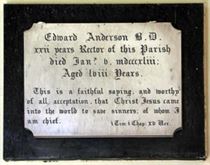
Edward Anderson 1820
Edward Anderson was a Northerner having been born in Northumberland. He was admitted to Queen’s College, Cambridge as a sizar on 31 March 1803. He obtained his BD in 1810 and elected a Fellow in 1819. He was Vicar of Cumwhitton in Cumberland from 1808 to 1821 before coming to Hickling in 1821 where he was rector until his death on 6th January 1841.
He oversaw the partial rebuilding of the rectory and the finalisation of the paving of the chancel during his time in the village. Towards the end of his days he organised the collection of money for the poor. The forty pounds which he raised regularly provided bread for the poor people of Hickling for more than a century but by the 1970s most people would have been offended at being thought of as poor. He lived to see the installation of his beloved Briceson organ for which the parish had subscribed £160.
He and his wife, Anne, had a son and two daughters who were grown up by the date of his death. His son was William Paley Anderson who became a Fellow of St John’s College and then of Emmanuel. He was also Prebendary of Wells. His sister, Catherine, who was living with him died a few years earlier.
William Henry Walker 1840
William Henry Walker was the son of Edward Walker of Overhall, Gestlingthorpe, Essex where he was born on 4th June 1796. He was a Bye Fellow at Queens’ and became Bursar there from 1836 to 1844 and was Rector of St Botolph’s. a College living, while at Cambridge and served as Chaplain to St George’s Hospital in London.
He married Catherine Anne Wilson, daughter of J E Wilson of Cambridge. She was twenty years his junior and by 1851 they had a daughter aged six and a son aged four and her brother was living with them.
He oversaw the rebuilding of the chancel between 1843 and 1845. He died at the comparatively young age of 57, leaving a wife and young children. He is buried beside or perhaps underneath the yew tree immediately South of the chancel. His brother-in-law, John Wilson is buried alongside him. He had lived with William and his wife for many years. His wife, another Catherine preceded him to the grave a year ahead of him. He died in 1874 aged eighty six, she a mere seventy three. Before he died, he published and edited “The sermons of William Jones FRS”.
William Henry Edwards 1857
William Henry Edwards had been another sizar who was admitted to Queens’ 1837 and was elected a Fellow in 1841. He was a Welshman and in his years at Cambridge served as Proctor, Bursar, Praelector and Rector of St Botolph’s.
He was instituted at Hickling in 1857, having previously been Curate of Aveley in Essex. He was soon supervising the rebuilding of the tower.
In 1873 he saw number 2 bell hung in the belfry.
Sadly, his health began to trouble him and he had to go for a rest cure in 1873. He died on 21 December 1882.
Thomas Skelton 1875
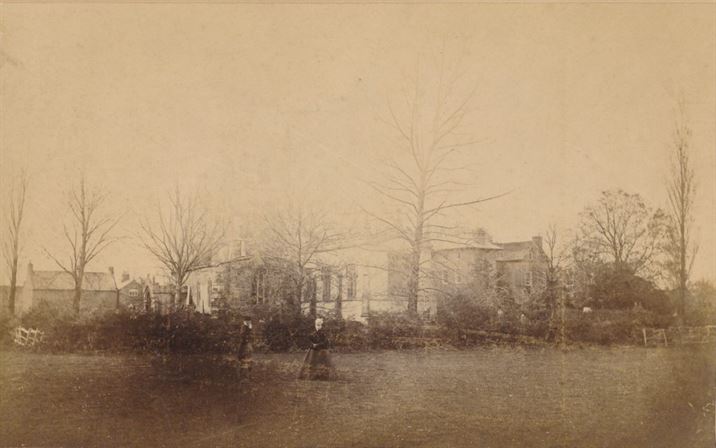
Thomas Skelton was the son of Spencer Skelton of Sutton Bridge in Lincolnshire, born on 1 February 1834 and attended City of London School. He was a clever man, and won a Scholarship to Queens’ gaining the position of sixth Wrangler in the examinations for his BA. He went on to get his BD and was elected a Fellow in 1857.
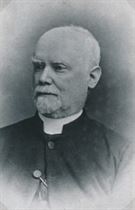
After Cambridge, he sailed to India and as one would expect of a member of the Society for the Propagation of the Gospel became a missionary in Delhi. He was sent there to restore people’s shattered faiths following the forceful British revenge for the Indian Mutiny.
His academic training led him to become Principal and Professor at Bishop’s College, Calcutta. On his return home he lectured at St Augustine’s College, Canterbury. His leadership qualities and experience in India were given rein with his observations to Astronomer Royal at Cape of Good Hope, Radcliffe Observer at Oxford University and Astronomer Royal of South Africa. His pastoral career followed the usual path: Curate of Wigginton, Oxon. 1874-75, Curate of St John’s, Battersea 1875-77.
He was instituted Rector of Hickling in 1883 and during his time at Hickling he served from 1884 to 1901 as Rural Dean of South Bingham. He was rewarded for his untiring services in 1895 by being made Prebendary of Lyddington at Lincoln Cathedral. He resigned in 1904 and died on 11 March 1915 aged eighty.
In his spare time he liked watching cricket.
He had married Matilda Lining, the daughter of Major General David Birrell in 1859.
In June 1902 Rev Thomas Skelton reported: “The Collection for the Coronation has realized the large sum of £35, which the parishioners summoned to a parish meeting for the purpose, have voted entirely for festivities. A vote was also passed, expressing a desire for a Service in Church, a wish with which the Rector and his Assistant Curate gladly comply.”
Francis James Ashmall 1905
Francis James Ashmall was the son of Elias Ashmall, born on 17 December 1856 at Hammerswick in Staffordshire. His sister was Lady Cooper of Shenstone Park Lichfield. He attended Cannock Grammar School followed by Queen’s College, Cambridge where he obtained 2nd class honours in the History Tripos in 1881, followed by an MA in 1885. He was ordained deacon in 1881 and successively became: Curate of Fareham 1881-86, Vicar of Holy Trinity, Southampton1886-96 and Rector of Bishopstone 1896-1905.
He arrived in Hickling in 1905 much to the regret of the villagers of Bishopstone. He was a billiards player and played for the village team. He wrote with a smallish, neat hand and kept meticulous records but was unable to increase the meagre congregations. His administrative abilities were recognised when he was appointed Rural Dean of South Bingham.
He comes over as a very warm character, who took a considerable interest in his parishioners. He was a great raconteur with a dry wit and must have cared deeply for his flock and thoroughly enjoyed joining in and arranging Church related activities for them. Yet his petty foibles show through. He was somewhat aggrieved when his sexton cum gardener/handyman volunteered to join the forces in 1918, feeling, quite rightly in my opinion, that he would have been doing a better service to his King and Country on his back door step. No doubt, Kitchener’s clawing finger must have poisoned him with a deep sense of guilt. Ashmall did not share the enthusiasm of the majority for a fancy dress parade in 1922.
He was rewarded for his labours when he was made honorary Canon of Beckingham.
He retired in 1927 to live in London, finding a comfortable abode at 22, Grand Avenue, Muswell Hill, having a long time to enjoy his retirement and 22 Grand Avenue would have prided itself on a large billiard room where he could practice all day long. When not doing this he would read and carry out a few clerical duties.
He lived to the ripe old age of 92, dying on 5 May 1948. He left to Hickling church his chalice.
*[… here, or to supply it to some other centre or fund, where help is needed.]
*[Those entries relating to purely secular matters are dealt with in the first part of this book. The offertory figures are ell recorded and make depressing reading. See table on appendix […]].
Many events in Ashmall’s time here are vividly recorded by him in the pages of the South Bingham Deanery Magazine.
In June 1902 Rev Thomas Skelton reported:
“The Collection for the Coronation has realized the large sum of £35, which the parishioners summoned to a parish meeting for the purpose, have voted entirely for festivities. A vote was also passed expressing a desire for a Service in Church, a wish with which the Rector and his Assistant Curate gladly comply.”
In 1906 Rev Francis Ashmall reported on the Sunday School outing:
“The Sunday School Treat took place on Monday, August 20th, and was a great success. We understand to the extent of 108, 57 scholars and 41 adults with 7 visiting children. By means of 11 spring carts these were carried to Trent Bridge, where the party embarked on the Steamer to Colwick Park. Braving the still waters of the Trent we landed, after attempting to steam through the bank. Colwick Hall was a pleasant resort; you can there get ice creams, a hundred laughs for a penny, either at your own expense or that of others, a cool seat in the shade, a shady walk around the lake of lilies, large mud possibilities, the sight of wild beasts and caged birds for a small sum, a really sufficing sniff for nothing, a playground and sundry other delights. At 3.45 the children found a very nice tea laid out for them in the Ball Room, very tastefully served, and to this they did ample justice. Thence they adjourned to to see the wild beasts fed. It was an angry and exciting moment, straining the relations of Mr and Mrs Wolf, but Mr gave way politely to Mrs – Mrs had first choice and Mr took the scrag end. The adults then partook of an excellent tea, after which they adjourned to the Sports Ground, where races were run for prizes. The chief winners were John Mann, Bertie Ward, John Faulks, Mabel and Ethel Marriott, Elsie Doubleday, Florrie Mann, Beatrice Collishaw and Willie Lester. Mrs Woolley won the Mothers’ race and Mr Arthur Shelton the Mens’. On the return journey, biscuits and sweets were distributed on the boat, and the procession of vehicles over Trent Bridge and through West Bridgford was quite imposing. Home was reached about 9;15 pm after a most happy and enjoyable day’s pleasure. The carts were lent by Messrs. G Collishaw, J Collishaw, Edgson, G Faulks, G Mann, J Mann, J Rippon, J A Roe, I Smith, T Wiles and E Woolley; the biscuits being the present of Messrs. Skinner and Rook and Messrs. Armitage; to one and all of whom our warmest thanks are accorded”.
Easter Sunday 1907.
“Easter was a very bright Festival. The beautiful weather made it ideal, and added a special beauty to it. All hearts were warm and glad and in time for celebrating so glorious an event as the Resurrection of our Blessed Lord. The number of communicants was four less than last year, and the offertories were more than three times as large. The services went very well. We were somewhat ambitious in attempting Barnby’s anthem, “Break forth into joy” and found it just a little beyond our powers to render it adequately but it was a good attempt. Woodward’s Te Deum and Turner’s Nunc Dimitis went very well, and as the congregation get to know them, I think they will find these settings to the Canticles are more expressive of their worship than the old familiar chant tunes, under which the soul often feels sleepy. Many who usually decorate were busy with household cares and could not help, while Easter Eve also saw John Peel in the saddle and Jane Peel not far behind him, in pursuit of Master Reynard. In such circumstances, the work was in the hands of a few. Mrs Ashmall, Miss Corner, Misses L and K Collishaw, and Mr and Mrs Hill, who made the Church very pretty, quite at is best.
Rev Ashmall went on to say:
“Most of you are aware that we purpose having a Sale of Work in aid of the Church Roof and Bell Fund in August, probably the first. We all know what the roof is like, when it rains, like a moth-eaten umbrella. If those who do not know will come to Church the next wet Sunday and take notice we will not be lacking in supporters, wo are convinced that something must be done. Now what can be done? To obtain this, money is required, and to get this money or as much of it as we can, we are going to have Sale of Works. Let us see what we can do, and what we can do by pulling all together. We will not forget what Canon Skelton did by patient unwearing work through those patient years, building up a fund that now is £163. We shall want three or four times this sum to re-roof the nave and South aisle, and £90 to re-hang the Bells – say £700. Thus, we want to get £537 more.
I am not telling you these figures to stun you, but to help you to realize how we need to steady ourselves for a really serious effort. Let each who loves our beautiful dear old Church at Hickling, which has been God’s Home on earth to so many generations of our forefathers, do what he or she can to make this Sale a success. We want a Needlework Stall, plain and fancy, a Dairy Stall, a Poultry Stall, live and dead, a Flower Stall – Refreshment Stall. We hope to arrange several Side Shows in connection with it and to obtain the service of a Band. Will every one do what they can to help?”
In September 1907, he reported on the Sale of Work:
“The Sale of Work took place on August 1st, and was in every way a great success. The weather was really beautiful, and coming so propitiously for us in such a season as this has been, we have very much for which to be most thankful. Thanks be to God! Kind friends both near and far were most kind and most generous in the gift of suitable articles. I wish I had space in which to record their names. but this would comprise most of the chief families of Hickling and some 30 families of Bishopstoke, Hants, together with a very large number of the personal friends of the stall holders. There was a goodly selection of choice articles, and in the name of the whole parish I thank the givers most heartily, one and all. A list of those who sent donations in money will be found below.
The Stallholders and a goodly band of willing workers were early on the scene, making the garden gay with flags, decorating the stalls and filling them with wares. During the morning were heard one or two questions as to what would happen if it rained, but the ladies kept steadily on dressing their windows, and the sun shone on, dispersing all fears. At 3pm a capital company was present, when the Rector in a few words explained the objects of the sale and introduced his sister, Lady Cooper of Shenstone Park, Lichfield, who had kindly motored over to open it. She made a very pleasing and appropriate speech, wishing the show every success, hoping the sum required would soon be raised and the necessary work on the Church Roof and in the Belfry soon done. A vote of thanks on the proposition was proposed by Mr W Collishaw and seconded by the Rev E Lennon Skelton. Then she declared the Sale open and business began. The result will be gathered from the financial statement appended.
The Tennis Tournament had already begun, there being 17 competitors. It produced some splendid play which was watched with great interest, Mr Claude Smith succeeded in getting some first rank platers to enter. The winners were Miss S M Hemingway and Mr Noel Brown. The prizes were kindly given by Mr Isaac Smith. The Putting Competition was won by Mrs Ling, who did the clock and the ladder in 39, while Mrs Ling and the Rev E Lennon Skelton, whom we were all over pleased to see amongst us, won the croquet contest.
The Tableaux were really very beautiful and did great credit to Miss Wallis of Bishopstoke, who designed and staged them. The children were so steady and good, and on every hand sounds of praise and admiration were to be heard. Again, I regret I cannot give details. Mrs Ashmall kindly lent her piano. The Art Gallery was in its way, especially in its in-take, a great success. One man said, ‘When I first came in and saw the miscellaneous collection of things on the table I thought it worth a penn’orth, but when it was explained to me, thought it worth a tanner.’ Mr Hodson was a very good whipper in and some 190 visitors attended. With such a range for art, the success of the School children in various outside competitions is explained.”
Numerous credits are then given and then an entry to say:
“The Band dispensed merry music all the day and did this at a reduced charge, which we much appreciate”.
In February 1912 Rev Ashmall reported:
“The Christmas Festival was a very happy one, though the weather was not of the Christmas Card type but was soft and mild. The Services were well attended and the number of communicants was 51 – much the same as last year. The Carols on Christmas Eve and the Special Music on Christmas Day were pretty and well rendered. The anthem was “The Light has Shined” by Simper.
The Social on January 15th was a great success. The Concert was a very attractive one, an excellent programme having been provided, while the Dance was largely patronised and was much enjoyed.”
Another Sale of Works took place on August 8th 1912 when the Long Clawson Brass Band played. In addition to the stalls, tennis and putting there were skittles and a hat trimming competition for men.
On 26th July 1915 the Sunday School Treat was held. This year there were the usual running races before and after tea. Although, walking races rather than running were held but with some novel features which made things interesting. “The field was too wet for use. Prizes were given to each child and the scrambling was very productive. The tea was much enjoyed.”
“We thank the Rev A W Bell for his sermon and address on July 25th, and we congratulate the many kind donors of eggs and flowers for their splendid generosity. 615 eggs were sent to the general hospital together with some beautiful flowers. Hickling deserves a warm pat on the back for this fine contribution which the Hospital much appreciated.”
The Rector reported on the Church roof:
“Alas! On 23rd August the East end of the South aisle roof collapsed at 11.15am. We have long been in anxiety about it, but were assured that there was no apparent immediate fear that it would give way, and we hoped that it might last until the war was over. Those who have seen the state of the timbers will wonder why it lasted so long. The first crash was ominous and fetched the Rector instantly from his study. When he reached the North door he saw the South aisle roof bulging in the centre, and almost immediately the big beam across the aisle came down with a terrific sound as of a bomb, leaving the other timbers hanging and cracking. This went on for five minutes when the whole of the roof timbers and the eaves crashed into the Church, raising a tremendous dust. The cause of the collapse was dry rot, and not a bit of the timber seems fit for future use. Apparently, the walls are uninjured, but the strain must have been great. The seats have been somewhat damaged and some of the lamps broken, but the wonder is that more damage was not done. We may be thankful that it happened on Monday and not on Sunday. The roof remaining will be shored up and be made secure and services will be resumed on Sunday next. It is an awkward time for such a disaster to have happened, but the fact is made abundantly clear that this work must be taken in hand at the earliest possible moment and the committee will take an architect’s advice as to the best course to take. One thing is plain. We shall want all the money we can get to make our dear old Church sound and safe, and we hope that kind friends assist us to the utmost of their power. Let us be thankful that it has happened as it has and that hidden sources of danger no longer hang over us, and let us put forth our best efforts to restore what is decayed and make our church a sure and safe habitation for the worship of God.”
In September 1916 he wrote;
“IN MEMORIAM JOHN GEORGE FAULKS The first of our village heroes has fallen. Some 40 young men of our village have joined the colours since August 1914, several have been wounded, but until July 1st, in the Big Push, not one has fallen”.
(More is written about him in the first half of this book.)
“The Church Council met on August 12th to consider the question of darkening of the Church so that evening services may be held as usual. The difficulties were felt to be too great, and it was thought best to hold the evening services in the Institute”
*[date?]
“THE CALL TO ARMS; Sixteen of our young men are on active service, some in France, some in training for the defence of King and Country namely: Edgar Barnett, William Collyer, Fred Copley, Frank Copley, Fred Crump, William Exter, John Hill, William Jackson, Wiliam Mann, Samuel Marshall, Howard Marshall, Joseph Marshall, Richard Marshall, Joseph Spencer, Frank Wright “God Almighty bless the boys” There is need for more men, Every man, if suitable age, fit physique, and free from ties that bind him to home, should decide what he ought to do and that regardless of what others do. ‘Your King and Country need you.’
The appeal is to the willing. It is a great decision to make, to offer your strength and it may be your life for our King and Country, for the defence of your dear ones back at home. We have to fight the foe abroad, if we want to save our land from the horrors that have befallen other lands. Many think that the authorities ought to summon to the ranks all whom they want. but for the present they appeal to the manhood of the nation for volunteers. We are to the brave lads who have accepted the call and we inscribe their names on a Roll of Honour and in the Registers of the Parish, and we pray God to watch over them, to inspire them with strength and courage for their every need to give them victory and success, and to bring them home again safe in peace. We are hoping to send each a Christmas present just to let them know we never forget them and ever wish them well. Contributions may be paid to Mr W Collishaw, and should be sent at once.
In March 1918 the Rector reported:
“THE HICKLING SOLDIERS WOOL FUND. Great credit is due to the children and to their teachers for the performance they gave on Feb. 11th and 12th in aid of this fund. The greatest skill was shown in the dressing and staging of the various pieces, and performers and audience thoroughly enjoyed it.”
Stainer’s Crucifixion “will be rendered by the united choirs on Monday March 25th in the chapel, and on Wednesday March 27th, in the church. A collection will be made towards the expenses, the balance to be devoted to the relief of the sufferers in Palestine.”
In November 1918 the Rector noted:
“Mr W Hill, our Clerk and sexton, joined the colours, and we shall sorely miss him. He has been a devoted, willing and obliging church worker, and this, added to his other work as the Rector’s gardener and all-round helper was national service of no mean order. When his country called him he responded without appeal and without hesitation.”
“NOTTS NEEDLEWORK GUILD Seven articles were sent. Why only seven? Where are the 63? Only two contributors? Surely a lapse of memory; we hope not a lapse of heart? Try and do better next time please.”
In December 1919 Rev Ashmall was writing again in the South Bingham Deanery Magazine:
“THE BELGIAN REFUGEE FUND. A very generous response amounting to 58/- per week, was given to the appeal for the Belgian Allies who have lost practically every earthly thing, Country, home, possessions, but not their soul as Punch’s splendid cartoon put it. It has not been possible to obtain more refugees for Long Clawson, and for the present their coming to England has been stopped. The Committee have consequently decided to go on collecting and to bank the funds for the present and will apply them either to the support of the Long Clawson Colony (or) if more refugees come, to minister to Belgians in this country. We owe this brave and heroic people a great debt, we recognise it, and we desire to discharge it, not simply as a debt, but in admiration for the righteous stand they made in self-defence, and in the deepest sympathy for them in the shameful sufferings inflicted on them by their inhuman foes.”
In March 1922 he wrote:
“THE SCHOOL MEMORIAL to those former pupils who were killed in the war was unveiled by Mr John T Lucas, the schoolmaster of most of them, on Sunday afternoon April 10th. It was succeeded by a service in the Church, conducted by the Rector, the Church being full. Thence the Congregation, comprising many of those who had served in the war, proceeded to the School where, after the Collect, the unveiling took place. Mr Lucas spoke of the difficulty of his task, as he recalled the lads whom they remembered that day. They had died solely in a noble cause, the cause of the spiritual versus the animal, of service versus dominion. He talked of the character of the warfare and made a strong and earnest appeal for support of the League of Nations as the only remedy for the horrors and evils of war, and the prevention of race and nation suicide. He referred with much feeling to those who had sustained these severe losses, and the presence of so many who had come through the fiery furnace, and were spared to their country and friends. He reminded us also who survive also the Great War and who inherit its burdens and its difficulties to live worthily, that those who had laid down their lives in sacrifice might know it had not been in vain.
The marble tablet placed on the outside of the West Wall facing the village street bears the following inscription:
In ever loving memory of seven brave lads educated in this School who fell in the Great War, 1914-1918
John Faulks
Stephen Crump
Jack Hill
Charlie Simpson
Cecil Simpson
William Salt
Samuel Doubleday
It is interesting to know that the work was by Mr Tom Drake, stonemason of Melton Mowbray, who was himself a fellow student of those commemorated.
We would like to add that the Bell ringers rang a muffled peal before the Service which was a beautiful and impressive feature of the ceremony.
THE PAROCHIAL CHURCH MEETING was held the same evening (March 31st) in the Institute and was attended by eight of our hundred of our enthusiastic Parochial electors. The requirements of commitments of the Church were discussed …”
In July 1922 Ashmall reported

“The Fete – At a meeting on June 20th it was decided to hold a Fete including Sports and Gymkhana on Thursday, August 24th, in one of Mr Luken’s fields, which he kindly placed at the disposal of the committee. There will be a variety of side shows including most of our old favourites. Skittles, a Hoop-la etc. also a Farm Produce, a Garden and Sweet and Refreshment Stall. A great demand was made for A Fancy Dress Parade, the penalty of last year’s success. After nearly twelve months, the vision of art and beauty and drollery remains and still we cry ‘Encore'”.
William James Dannatt
William James Dannatt came to fill the place which he had vacated but only survived six years, dying in 1933. This left him little time to have an impact on the parish but in 1931 his mother, Violet Dannatt presented the Communion Book to the church. He came with a missionary zeal to bring his new flock back to the communion table.
He wrote in the South Bingham Deanery Magazine in January 1931:
“A very Happy New Year to all. May the joy that no man taketh away from you be yours throughout 1931. We stand on the threshold of another year, wondering what it has in store for us. We know not but he knows. So let us go forward in trustful dependence upon our Lord and Master, seeking in prayer and worship and communion His Presence day by day. Then will we find in Him all that we need for each day’s life for ‘They who seek the Lord shall want no manner of thing that is good”. On the Feast of Circumcision or New Year’s Day, there will be Holy Communion at 8 a.m. Would it not be well if we all used this opportunity of starting the New Year by strengthening and refreshing of our souls at the Table of our Lord.
We owe our very great thanks to the Revd E.J.Palmer for the most interesting address he gave to us on the work of the Bible Society at Service on November 24th. It is regretted that the attendance was not larger. If the weather was bad, the cause was good: one that ought to appeal very strongly to the hearts of every Christian man or woman. We hope very much that interest and enthusiasm for the work of the Bible Society may increase and the support for it by our Parish be more in accordance with the great need the Society seeks to supply – the Word of God in their own tongues to all peoples of the world.
A very happy Christmas Party was held on December 19th, to which the children invited the School Managers. We had a thoroughly good time. There was a splendid tea and uproarious games, and the way some Managers renewed their youth was a joy to see. A most enjoyable evening concluded with the singing of Christmas Carols and prayer.
The Annual Parochial Church Meeting will be held in the Institute on Monday, January 19 at 6 p.m, to receive the Church Accounts and to elect the Parochial Church Council for 1931. It is earnestly hoped that all whose names are now on the Parochial Roll will endeavour to be present.
January 25th is Hospital Sunday, and the offerings throughout the day will be given to the Nottingham General Hospital. It is hardly necessary to remind you of the exceptionally large number of cases from Hickling which have received the care and attention of its doctors and nurses during the past year. We feel sure that a very good response will be made to this annual appeal. It demands and deserves the most we can give.”
In the April 1934 edition of the magazine it is written in Mr Dannatt’s words:
“Robert Daft – In the long history of Hickling Church there must have been many to whom our beautiful House of God was indeed a loved and hallowed place. But none, surely, loved it more or served it better than Robert Daft. To hear him speak of the “dear old church” was to realise that it had become part of his life, and worship and communion there were the most treasured joys of his heart. Though he often spoke of his end, and spoke of it with the glad confidence of one to whom the Christian hope had become a glorious reality, he long hoped to be spared just that he might the longer serve the Church that ne loved. And now he has passed on full of days, to be with the Lord he so faithfully and consistently followed, he has left behind him the memory of a man upright in his life, downright in his testimony to the faith that was in him. If he seemed intolerant of the slackness of others in their duty to God, but that was because he felt that such slackness was dishonouring of God. It shocked his sense of the honour and reverence due to Almighty God. But if sometimes he seemed stern and unbending, he also had a kind, gentle side to his nature. Above all he was a man of God, one who ‘knew in Whom he believed’, one who served his day and generation by the will of God. May the example of his life encourage and inspire many of Hickling to follow him, as he followed in the steps of his Master”.
Rev Ashmall was asked to add his tribute and he did so eloquently:
“I would like to add to the above, which I would heartily endorse, a few words of appreciation of this dear old man whose loss we mourn and for whose life and Christian Testimony we bless God’s Holy Name. Robert Daft was a native of this parish. In the early days of my ministry, 1911, he returned to us from Long Eaton, after the death of his wife, and took up his abode near to his saintly sister, Mrs Harriman, of fragrant memory. From the first his presence was felt, and the truth in him was manifested. He was a burning and a shining light amongst us. His light was not hidden under a bushel. If all did not rejoice in his light, no one had any doubt of the manner of man he was. There was the robust sturdy grace of John the Baptist in him, stirred in him by the indifference and carelessness to the things of God and man’s welfare.
A Christian is not just one who is different from others, but one who is used to change the lives of others. This was Robert Daft’s special characteristic – that as a layman he was never ashamed to confess his loyalty to God, Creator, Redeemer, Sanctifier, and in season and out of season, to testify to all and seek to bring all to the knowledge of the truth as he had learned it. ‘Thanks be to God’.
At the age of 86 years he fell asleep. An accident befell him on his familiar tricycle on January 27th; he fell asleep on February 20th and was laid to rest in the churchyard, a few yards from his home in the parish on February 24th. His body was placed in the Church he loved so well in the afternoon of the previous day. The funeral was attended by a large congregation, who had known, honoured and loved him, including one nephew and two nieces, Mr John Harriman, Mrs G Lakin and Mrs I Parkes, his daughter in law, Mrs Daft, widow of his only son, deceased; and their children. The service was taken by the Rev P Dressler, Vicar of Kjnoulton, who spoke in an appropriate address of his life, work and example. The hymns were, ‘For ever with the Lord’ and ‘ Now the labourer’s task is o’er’. The floral tributes from relatives and friends and included a cross from the congregation, Blessed are those who die in the Lord for they rest from their labours.
We are much indebted to the Rev P Dressler, the Rev J Wood and Mr Williams for their service during the vacancy of this Benefice, and would thank them and assure them that they have been greatly appreciated.”
Rev Dannatt’s end must have come quite suddenly for there was a long interregnum. The following appears in the South Bingham Deanery Magazine:
“Many of you are anxious to know who is to be our next Rector, and are praying that the College will have the guidance of God in making the appointment”.
Lancelot Wilson Foster 1936
Lancelot Foster arrived in 1936. He was a learned man and of sufficient means to keep the Rectory and its grounds immaculately. He showed an interest from the start in the history of the church and obtained a considerable amount or information on the subject from Southwell. He joined up early in the second world war and became an Army Chaplain. Hickling was thus denied his presence for much of his incumbency.
He was a graduate of Queens’ College and obtained his MA in 1925, having trained for the Clergy at Westcott College. During his training he had a spell as Curate of St Chad’s, Rochdale but his first substantial appointment was as Vicar of St Werburgh’s, Derby in 1925. He moved on to be Vicar of Buglawton in 1928 and thence to Hickling in 1936. After the war he had itchy feet, perhaps feeling that the pastures of Lockington would be greener. In 1951, a glebe tenant demanded that he should install drainage in one of his fields and as he was unwilling to lay out this sort of sum of money resigned as Rector of Hickling also resigning as Rural Dean of South Bingham. He moved again in 1958, this time to Burton Overy in 1958.
In the South Bingham Deanery Magazine of October 1935 he wrote:
“The choir outing was held on Thursday, August 30th. The choir and their friends filled all 32 seats of a luxury radio bus. We were fortunate in the weather, just a sprinkling of rain when we arrived at about 10 o’clock.then fine for the rest of the day. We all went our several ways according to taste, and met again for the return journey at 7 p.m. An enjoyable day was spent, my only regret being that so many of our regular members were unable to go.
The Parochial Church Council met at the Rectory on September 6 and decided, on the recommendation of Messrs. Taylor’s manager, to board up half the belfry louvers to stop the clashing of the bells in the immediate neighbourhood of the Church and to mix the sound better. This has now been done. We have received another subscription towards the work of 10s. this one from Miss Hallett of St Boise, Idaho to whom we are grateful.
It was decided to send the fruit and vegetables to the Eye Infirmary and it was decided to have the Church thoroughly cleaned through, and we must congratulate Mrs Aston, Mrs Wright and Mrs Murden on the excellent result of that labour.
It was decided to ask for estimates for the overhaul of the organ, so that we shall have some idea as to how much money it will be necessary to raise for the purpose and how best to set about it.
Hickling Church has no large alms dish, but it has a very nice old pewter basin which may be the ‘decent basin to be provided by the parish for that purpose’ as the Prayer Book says. We have decided to use it for that purpose.
It was also decided to hold a number of Lantern lectures during the winter of an instructional nature on such subjects as the organisation of the Church of England. I fear that there are still many people who know very little about how our Church is managed and who such people as Deans, Canons and Archdeacons are and what they do. I have even come across people who think that Bishops are paid out of taxes and rates. Slides are lent by the National Assembly for the purpose, and should be interesting. There will, of course, be the cost of hiring and posting the slides. We shall also have one lecture for the Waifs and Strays and one for Foreign Missions.
We are grateful to Canon Ashmall for staying in Hickling specially to address the Mothers’ Union. The weather was kind and Mrs Foster and I were pleased that so many were able to attend.
We wish Mr and Mrs Tom Munks health, happiness and success in their new house at Old Dalby. We shall miss them from their many activities and interests.
Your friend and Rector, Lancelot W Foster”
Leslie Thomas Prosser Harwood 1951
Leslie was educated at Trinity College, Cambridge, getting his BA in 1925 followed by an MA in 1930. Like Lancelot Foster, he was trained for the Clergy at Westcott College and he had a spell as a curate. He moved on to be Vicar of Temple Mills, Leyton from 1932 to 1942 and Vicar of New Basford, a rundown industrial area of Nottingham. There he married and had two children. His wife, however, died and he married secondly Barbara who was a local church worker and they moved to Hickling where they had four children and a boy who died aged eighteen months. Robin who was born in 1953, Chris, born in 1956, Kim, born in 1958 and Mandy, born in 1962.
Percy Campbell Cox 1975
Percy was born in 1922 and would have served in World War II before finding his vocation. He attended Bishop’s College, Cheshunt from 1955. He had two short spells as a curate and was then Vicar of North Harborne, near Smethwick. He was, however, dedicated to his service as an Army Chaplain, both at home and abroad. It was a difficult time for him when he retired in 1975. Hickling was not to his liking and who could blame him with the then state of the Rectory. His wife would have been disgusted by it. He stayed barely more than a year, finding pastures new in Castletown, Isle of Man. His entry in Crockford’s Clerical Directory bears no reference to Hickling.
For Hickling, he was a fresh strong wind sweeping the cobwebs away but we would have frozen to death if he had stayed longer.
Peter John Harrison 1976
Peter was born in 1940 and had long experience as curate, moving successively to Hucknall Torkard 1963 to 1966, Ordsall 1963 to 1966 to 1970, Carlton and Colwick 1970 to 1974. He found the duties as Vicar of Overton with Fyfield in Berkshire where he was from 1975 to 1980 (?) and had nine parishes to cope with a tall order and I suspect that Monica, his wife, was homesick, so he was delighted to take over the reigns of the United Benefice of Hickling with Kinoulton. The benefices had united in 1950 and that of Upper Broughton otherwise Broughton Sulney was added in 1980. He served as Rural Dean of South Bingham from 1986 to 1991. He changed his surname to Brameld because he did not want his mother’s family name to die out.
In retrospect it appears that Francis Ashmall was the last rector to partake in the day to day life of the village. He played billiards for the village and he and his wife went to whist drives. He reported on the cricket scores and village days in the South Bingham Deanery Magazine. In contrast Mr Dannatt merely reported on church affairs. Lancelot Foster was away for much of his incumbency and Leslie Harwood had too many troubles of his own and was always putting his foot in it. Peter Harrison lived in another world from us.
Mrs Stephanie Bridget Fahie 1995
Stephanie was born in 1948 and her father had been a priest in Kenya. She was trained for the priesthood at St John’s College, Bramcote, near Nottingham being ordained deacon in 1987. She served her apprentice ship as a curate at St Christopher’s, Leicester before being chosen as Priest-in-Charge of the united Benefice in 1995. As I write this, I feel as if I am living in a different time warp from the village which I have come to love in the course of writing this book with all its past characters rising from their long slumbers. The village community is hard to penetrate and despite having been church warden for twenty seven years, I have never felt part of it. I have deliberately not passed comment on our present rector because I believe that people can only be judged in retrospect.
Twenty Seven Years as Churchwarden
When we first arrived Eva Parkes was ever welcoming and Freddie Payne, one of the village’s real characters, acted as our watch dog.
I have great respect for John Walker, whom I hardly know, for his planting one of his fields with indigenous trees and the Collishaws who allow their hedges to grow and thus the wild life to flourish and in particular Richard Collishaw with whom I became friendly when we were both on the PCC. Ted Faulks will be at my funeral. Ever since our first days in Hickling, John Bloor has steadfastly kept the Parochial Roll and is now our church warden. I fondly remember some who have passed the great divide: Eric Chaplin who lovingly cared for our garden for many years and was always a friend. He grew the largest cabbages I have ever seen. Will Walker who was a tower of strength in the village and always treated me as a friend and Stan Watts, many years a sidesman and who mowed our grass and enjoyed a good chat with us. They were both cut off in their prime. God taketh those that are too good for us to deserve for his own.
Meanwhile congregations will dwindle and the lessons will shorten from four lines to one as our attention spans shorten. God will look on, knowing that he is largely forgotten, but that, when catastrophe strikes as surely it will and hard times hit us in our bellies, we will turn to him in droves.
Some Additional Notes (offered by a friend):
Mr Bob Trubshaw was a friend of Chris’s and is a well-known publisher of Nottingham histories. Sadly, Chris didn’t reach the point of final checking and proofreading of his history of Hickling and we are grateful to Bob for offering a few historical corrections:

